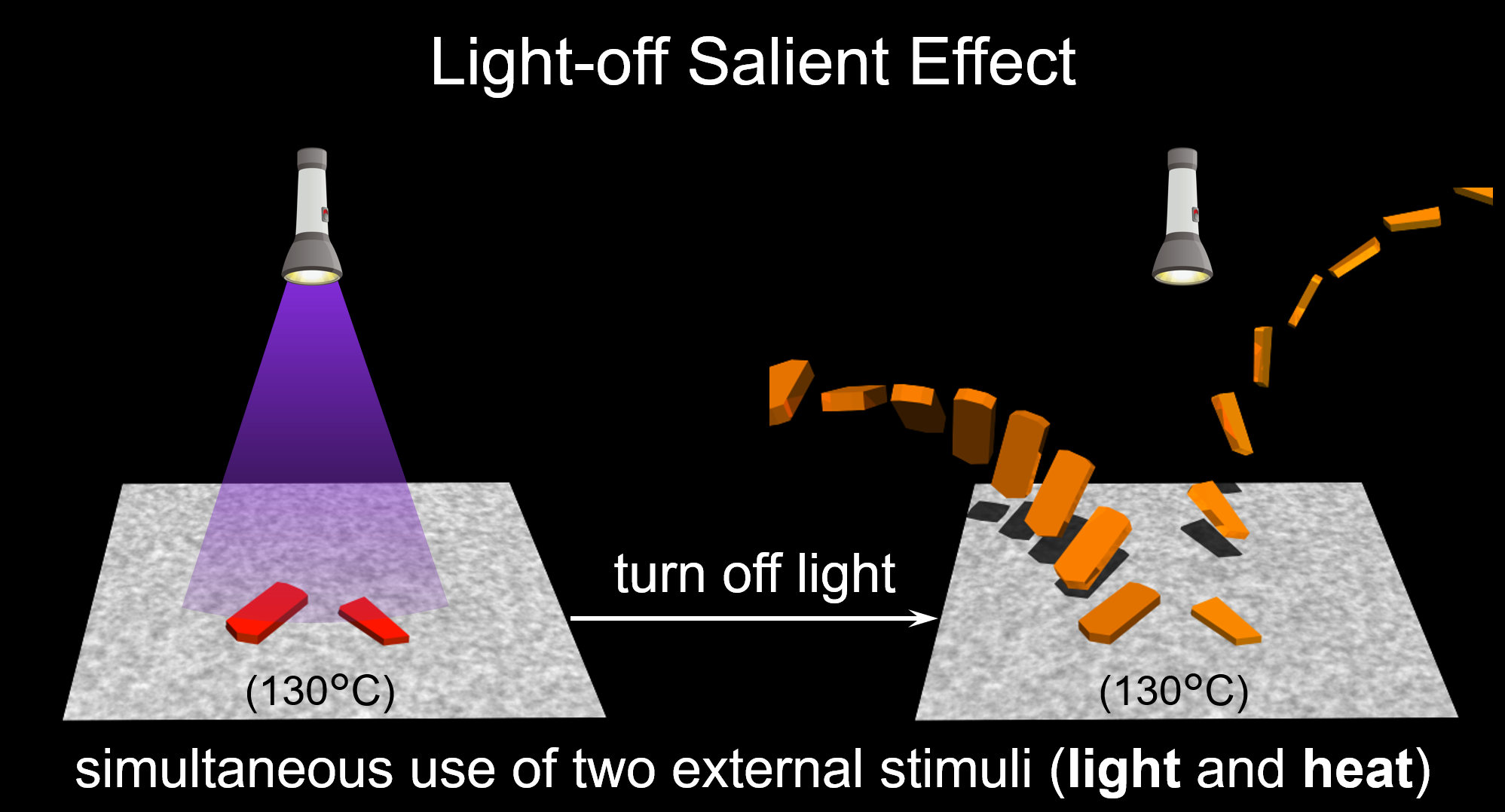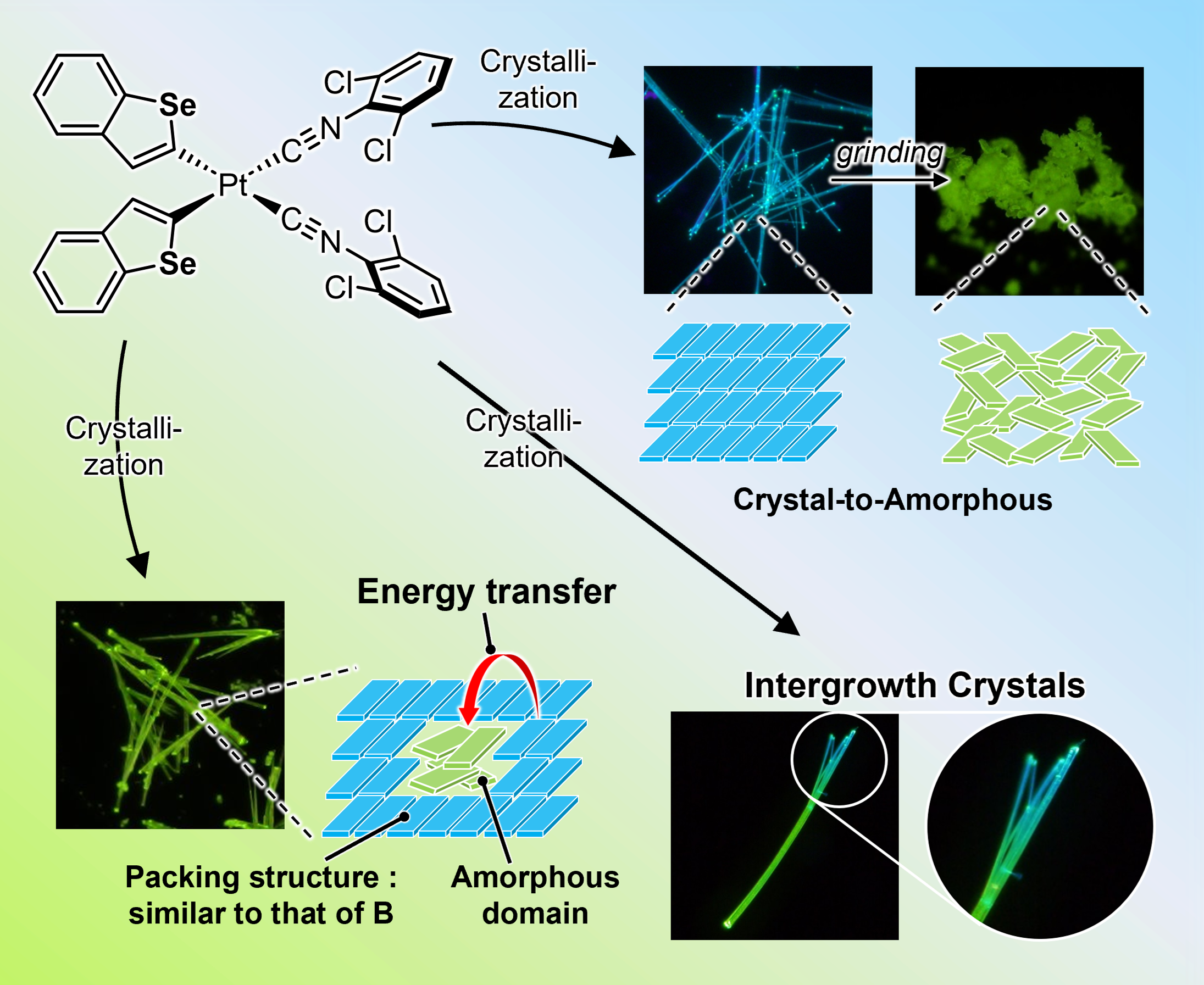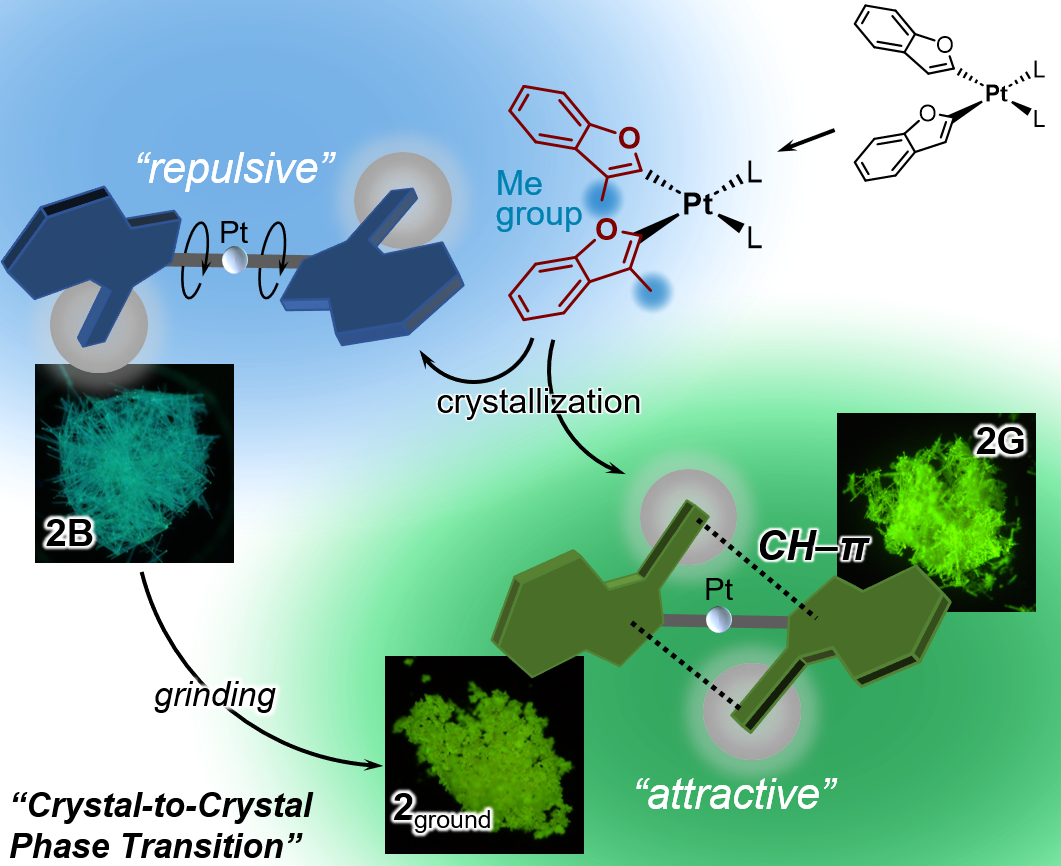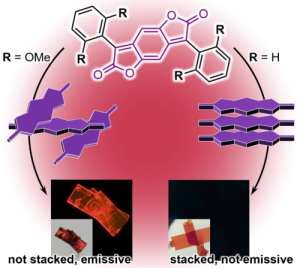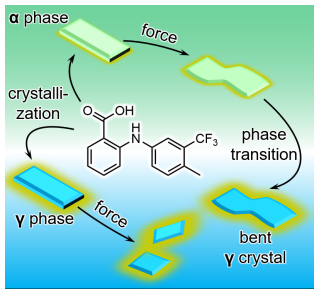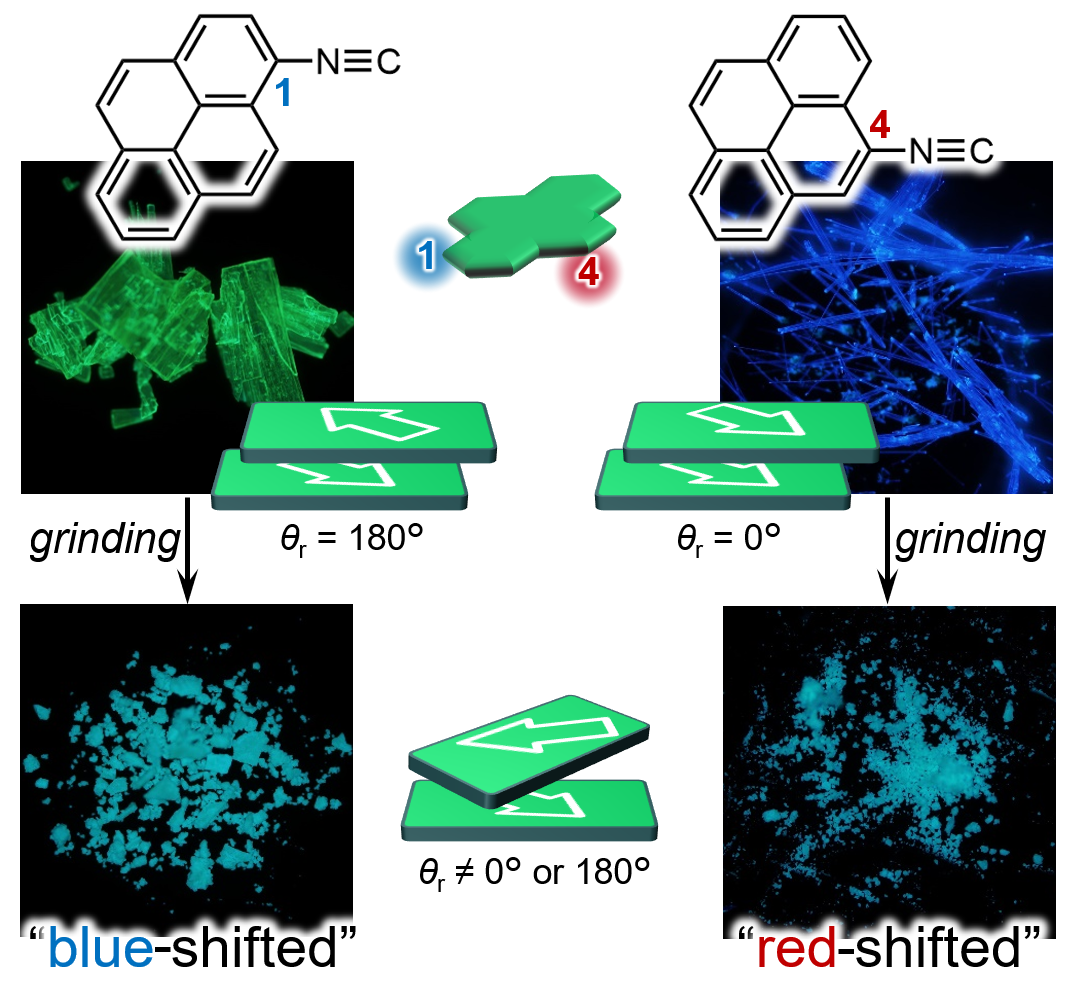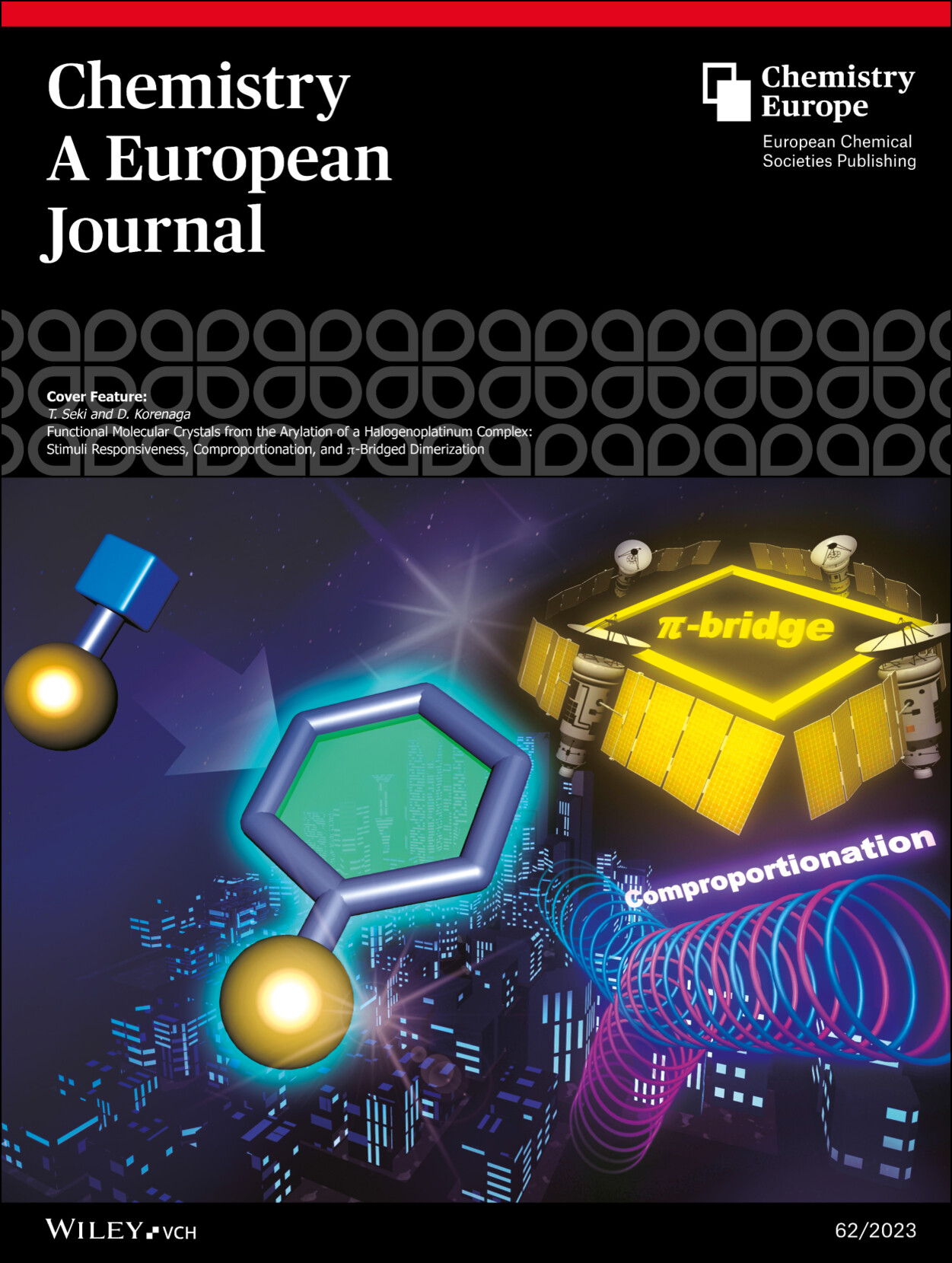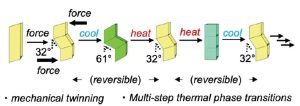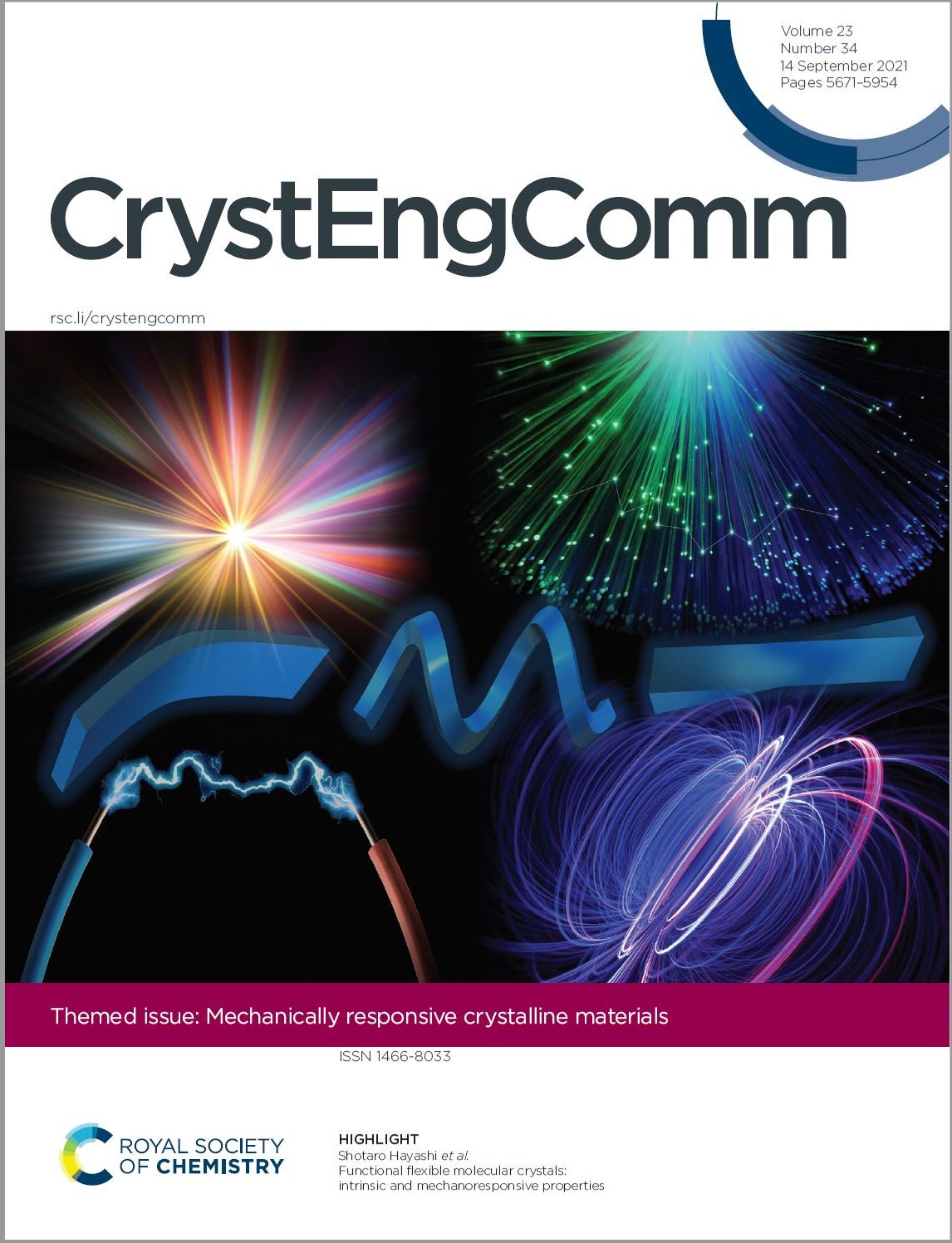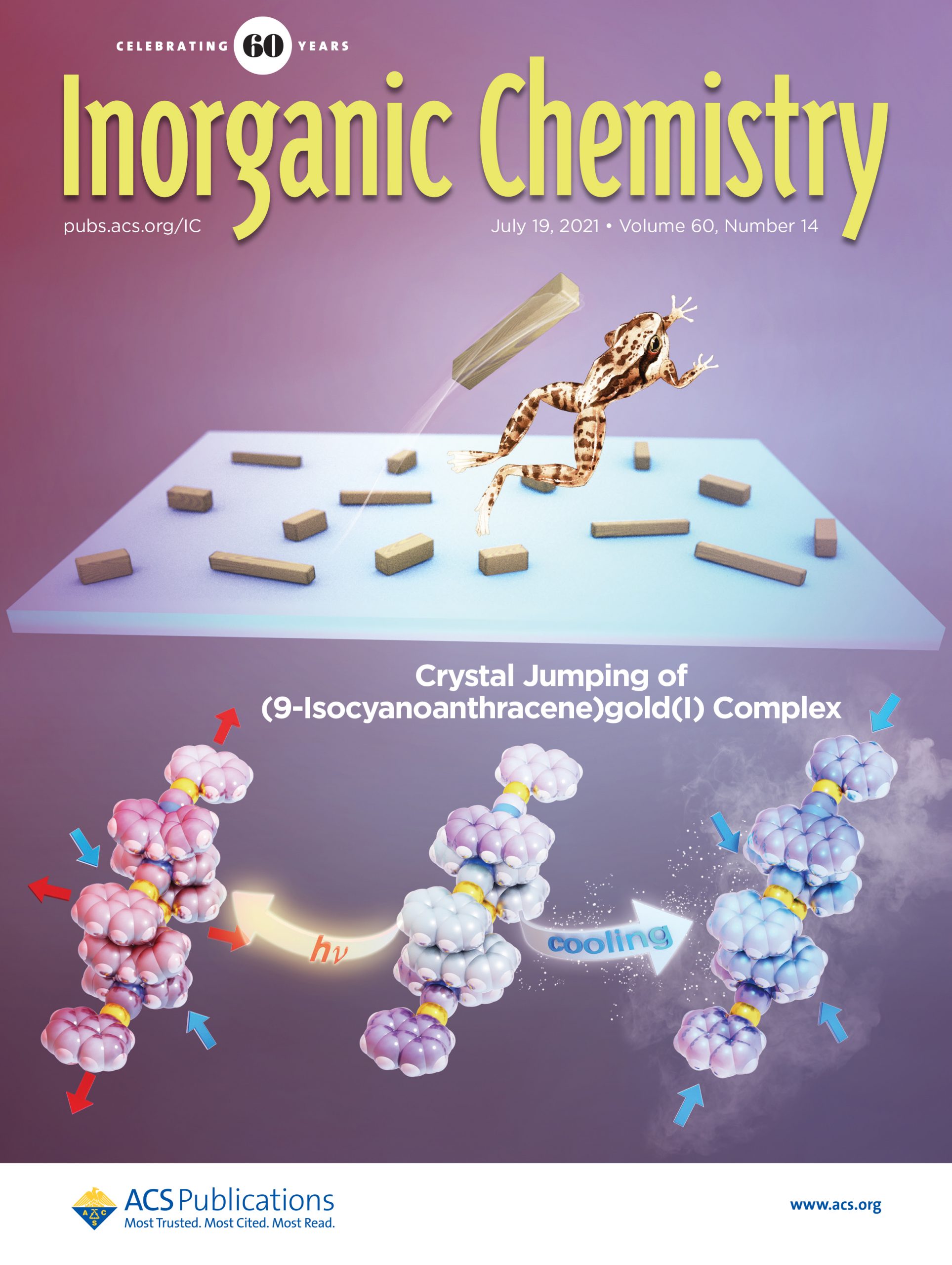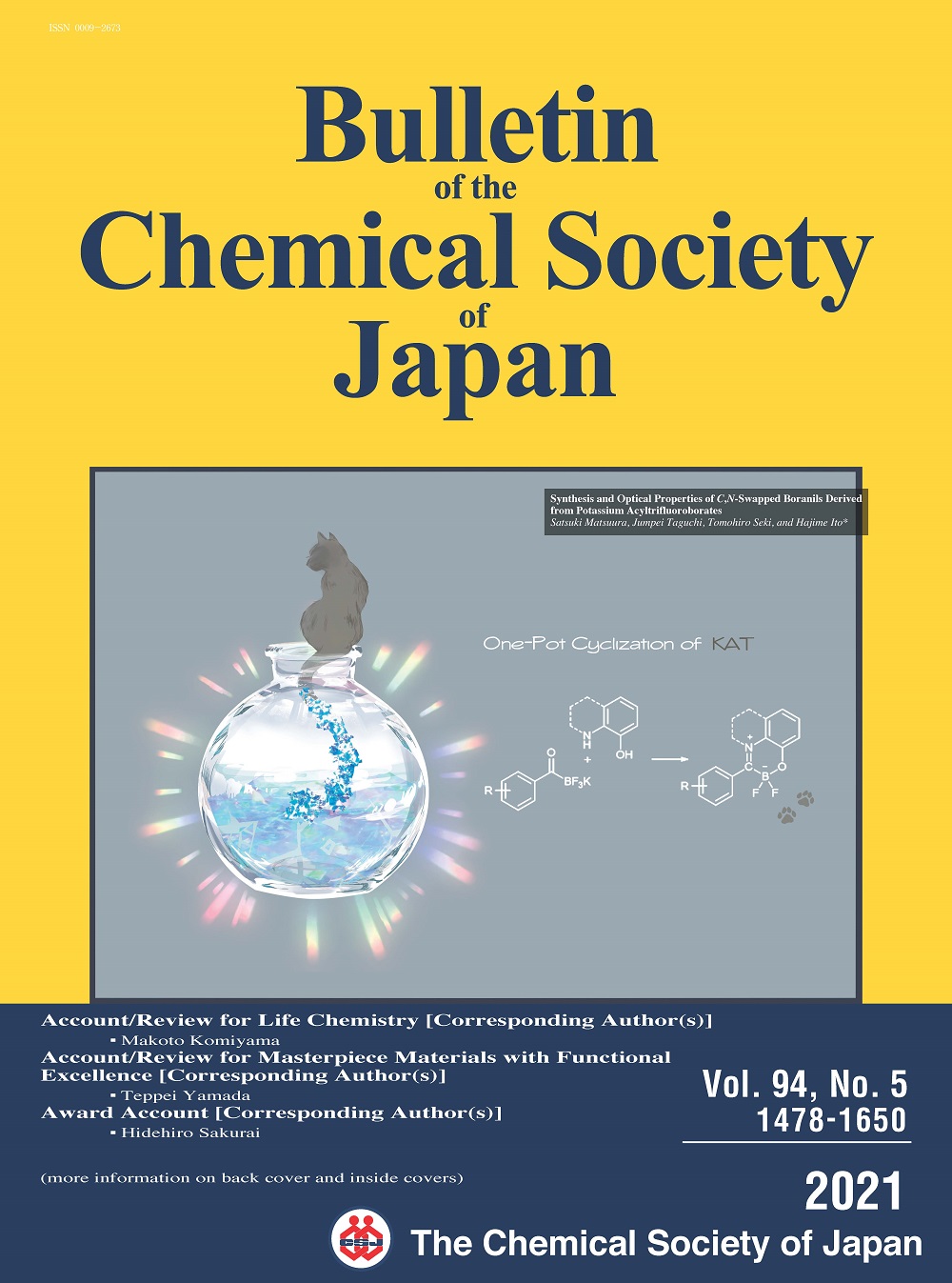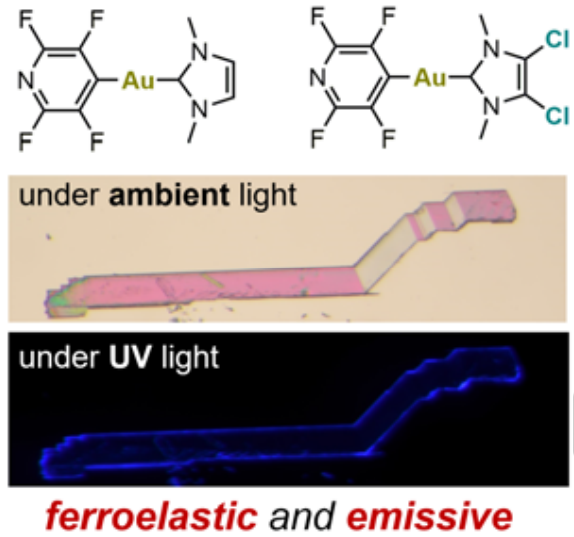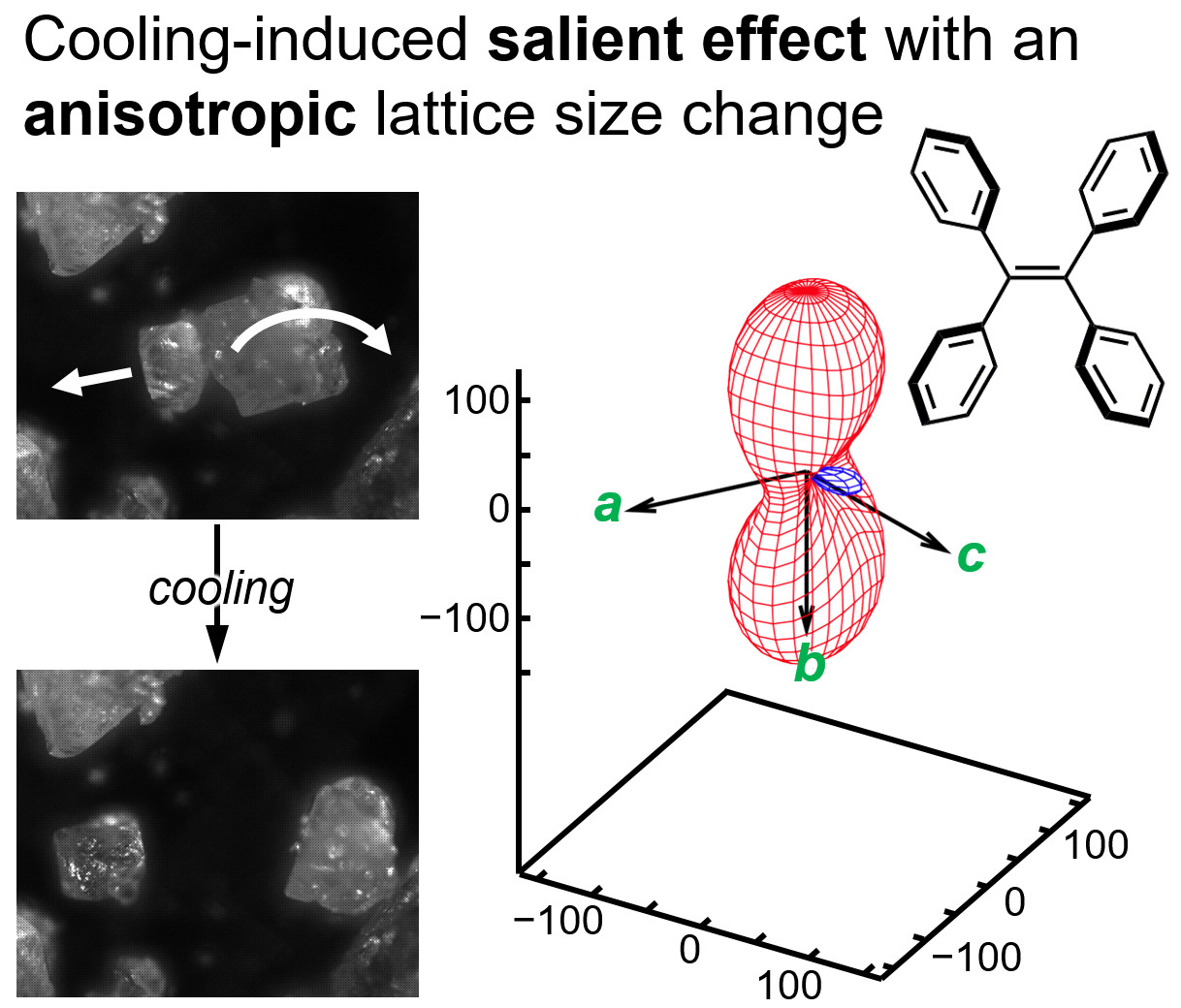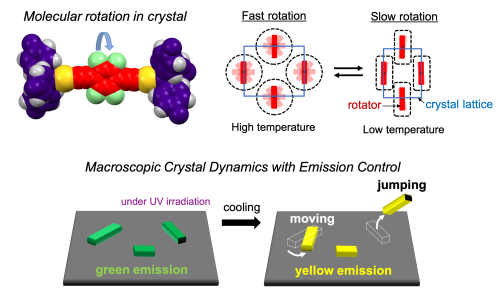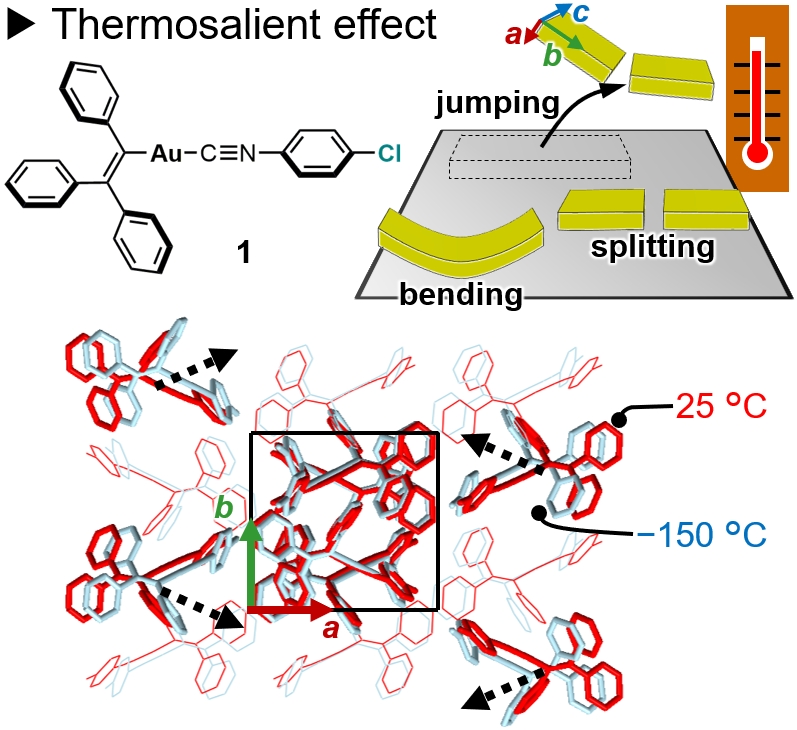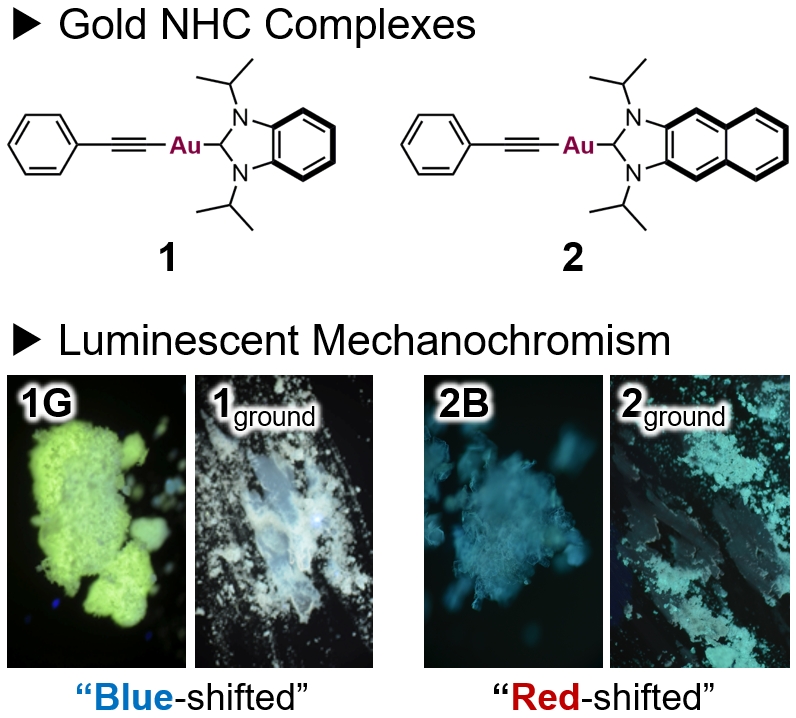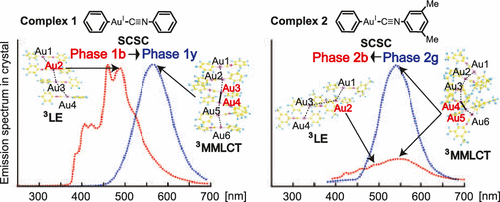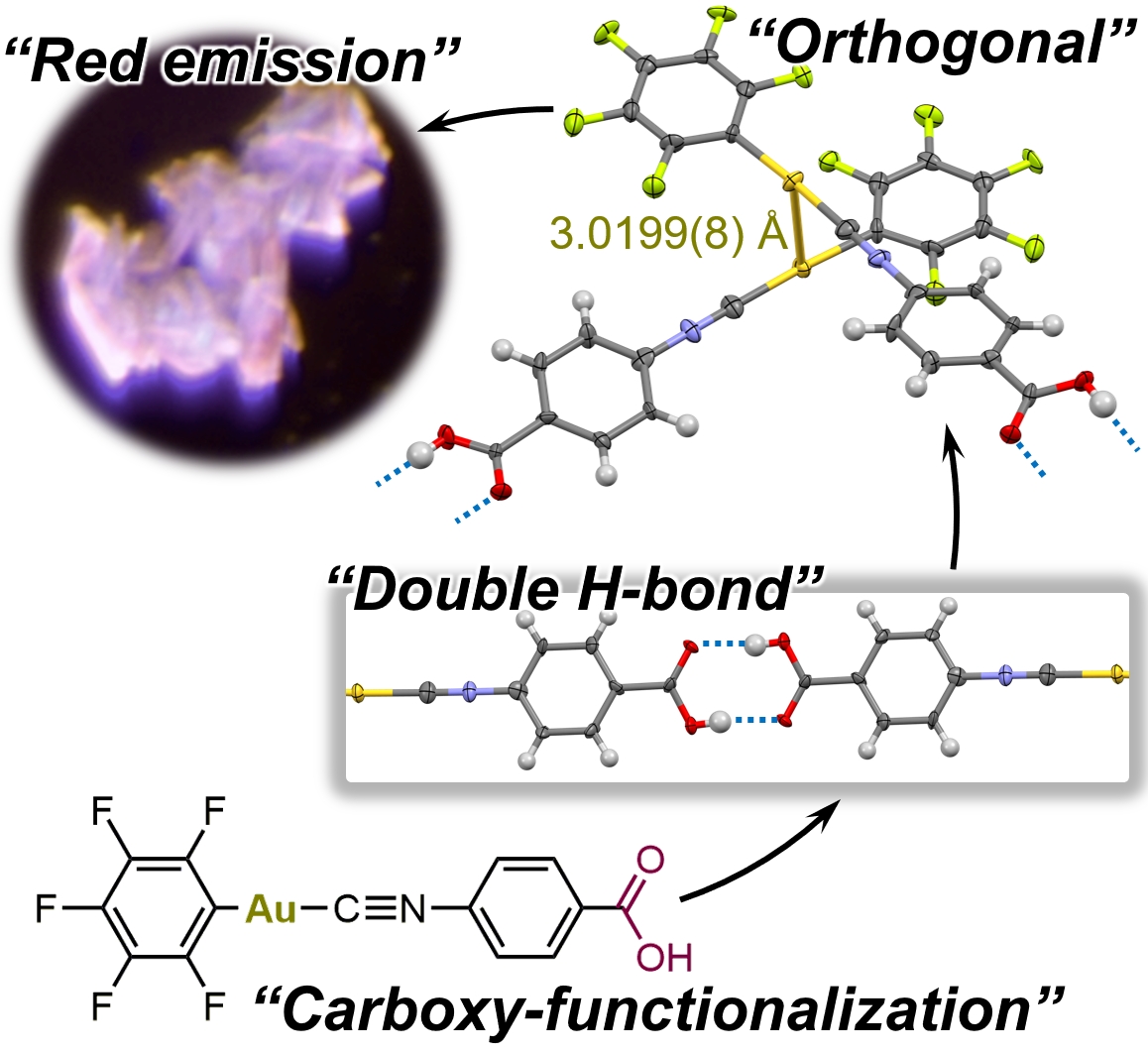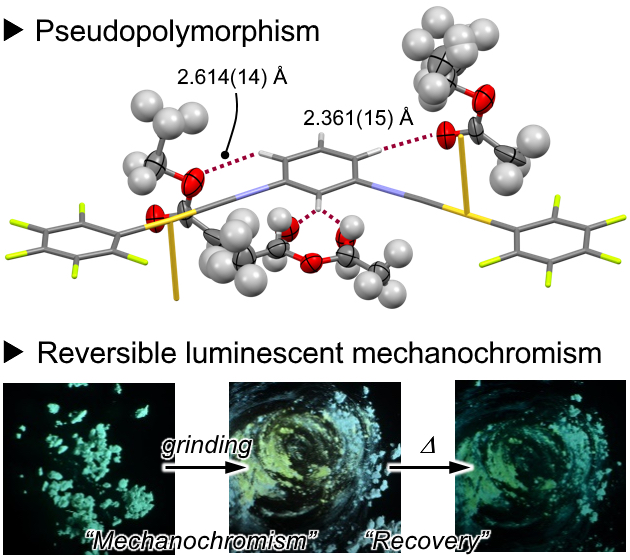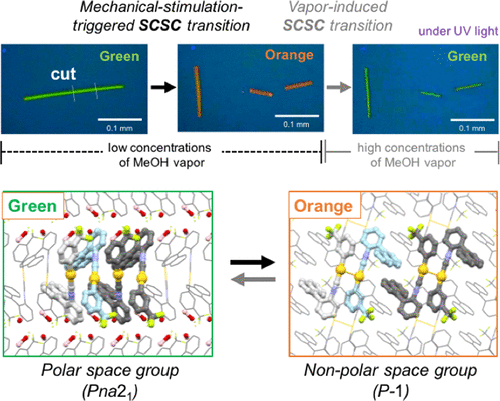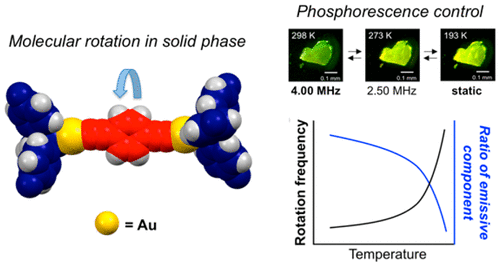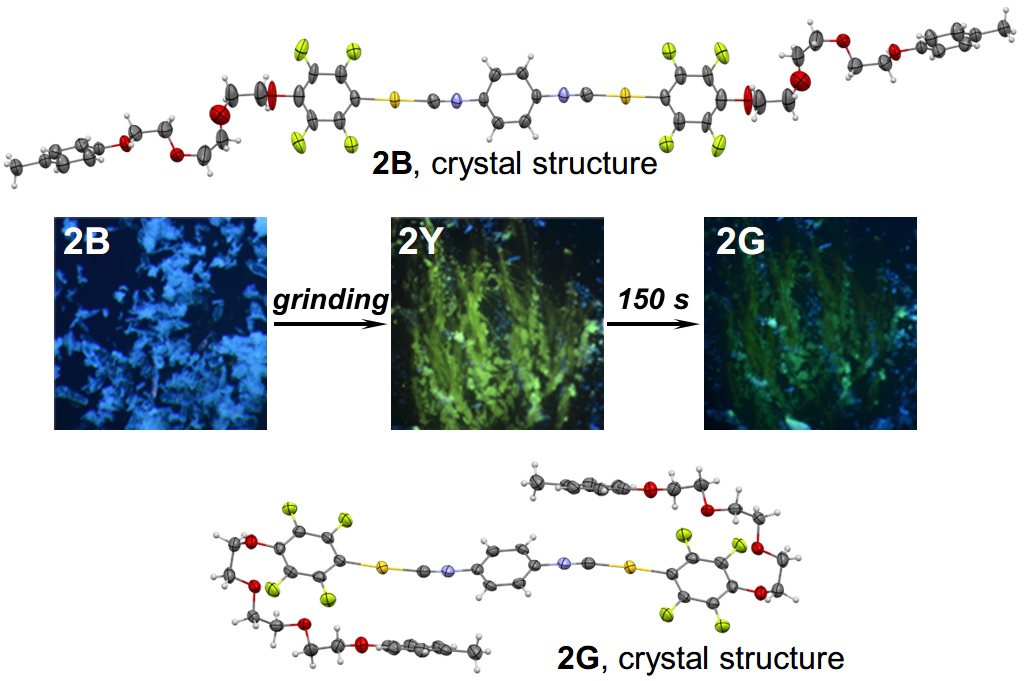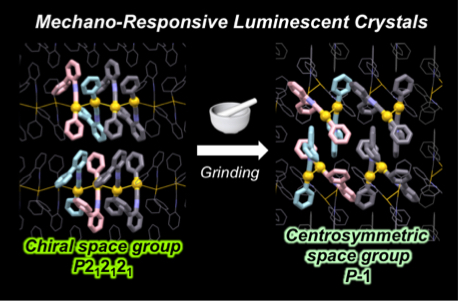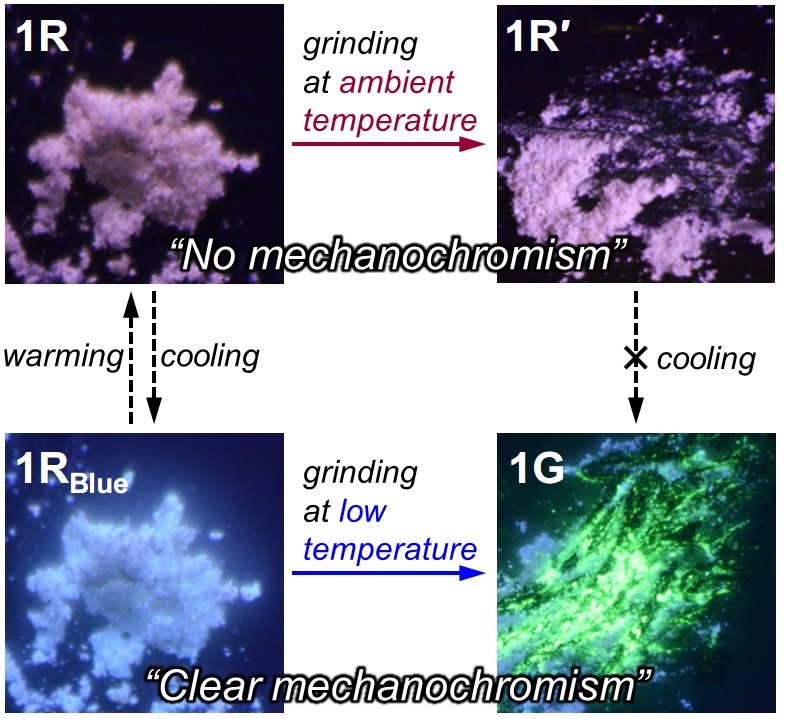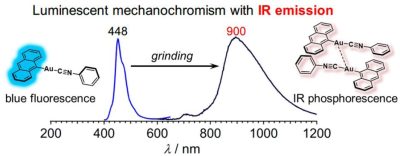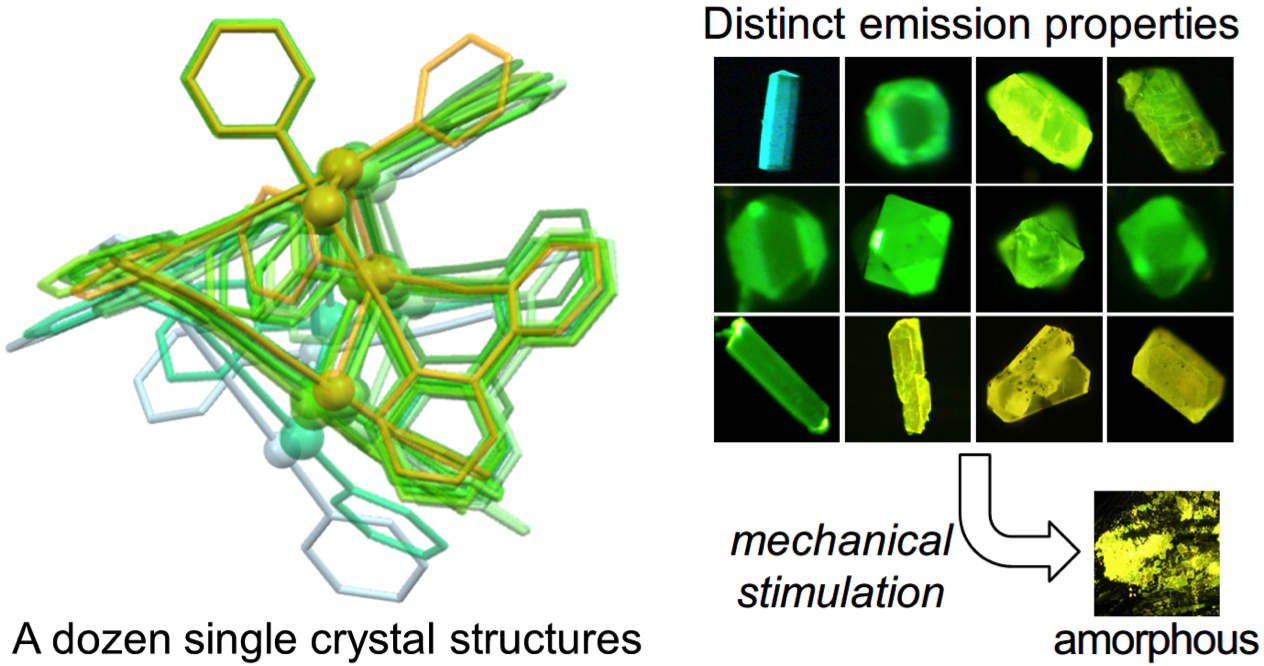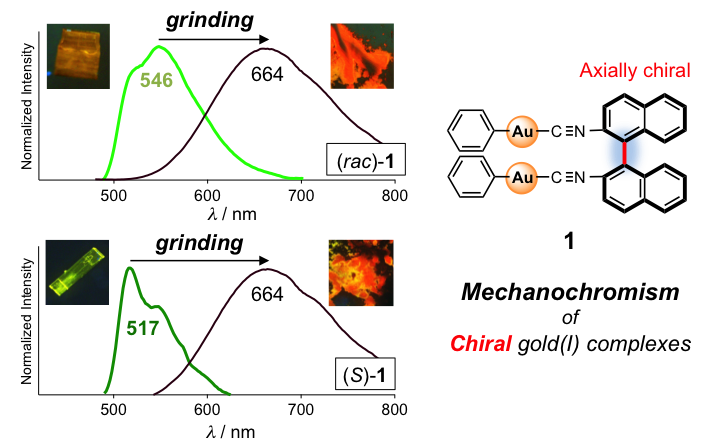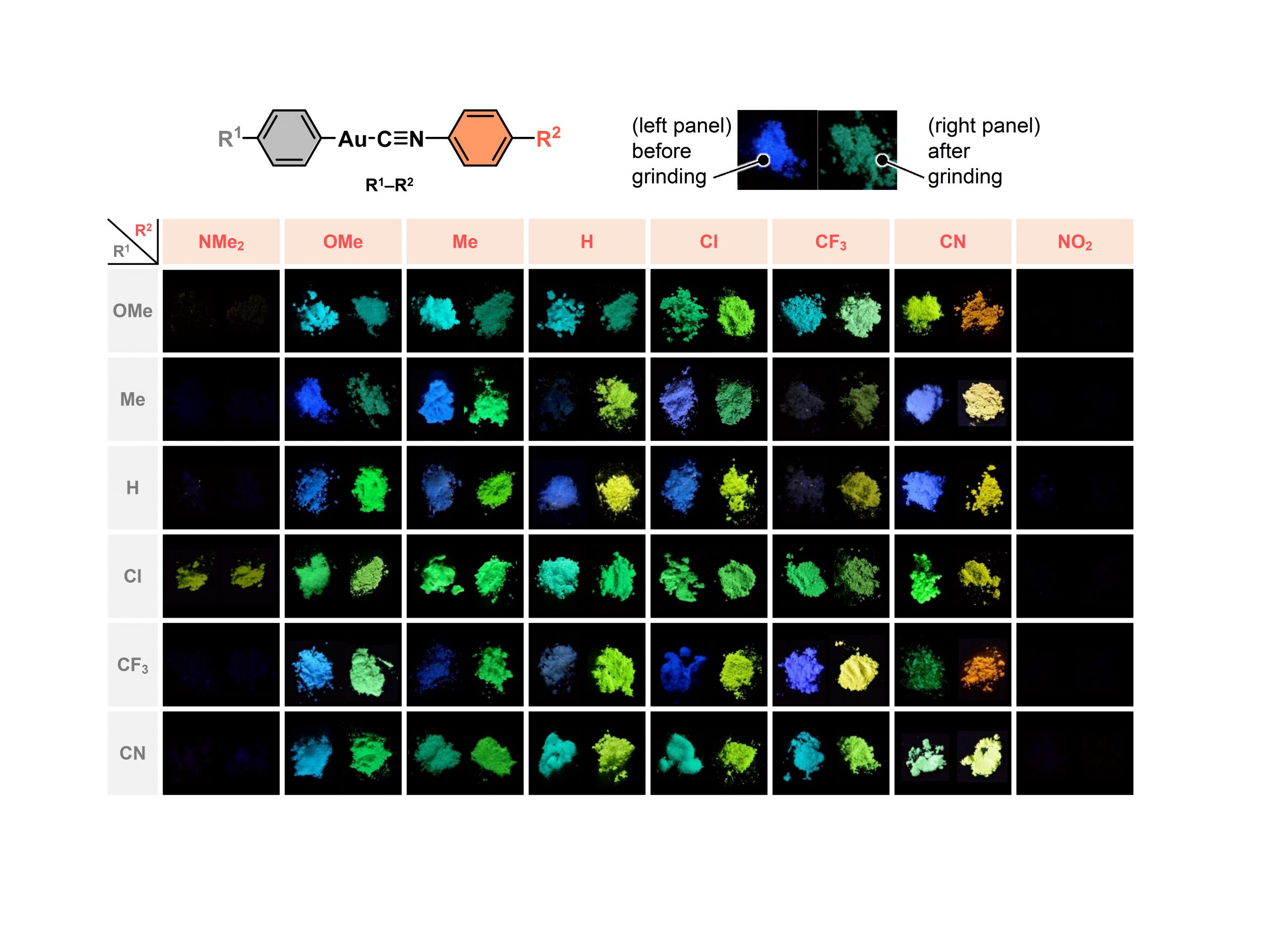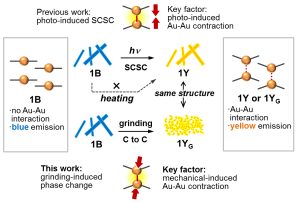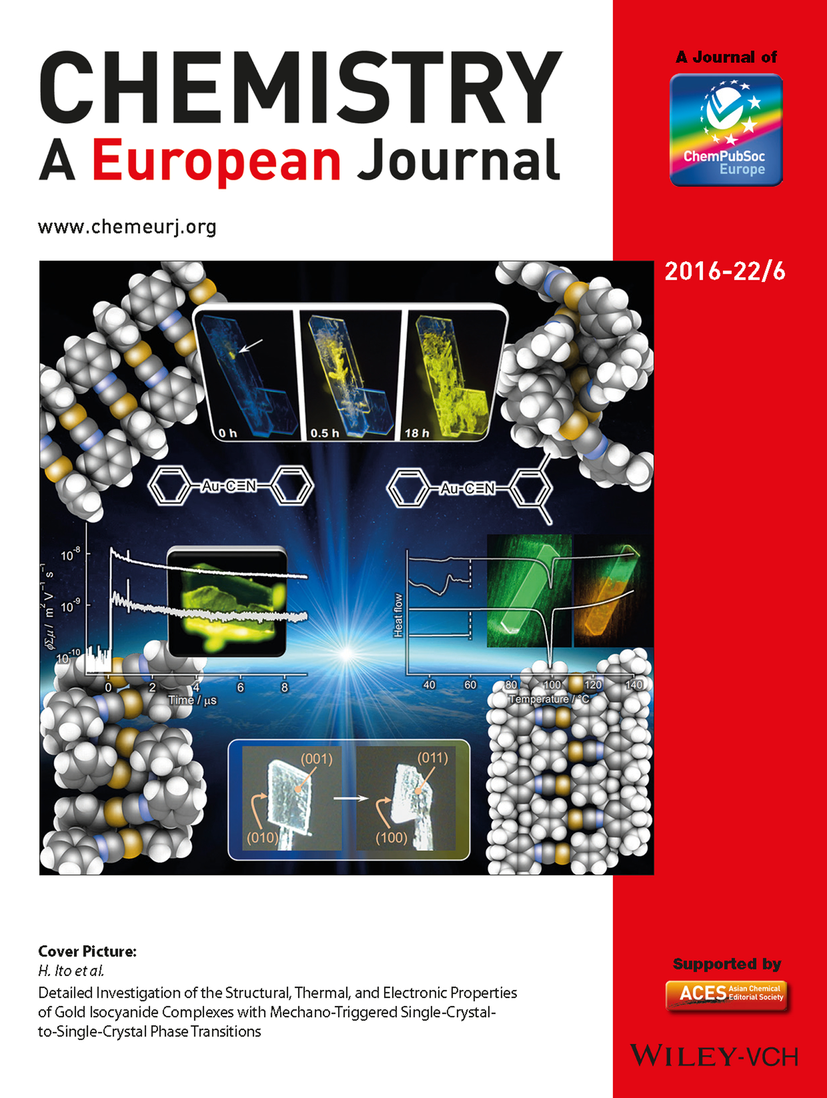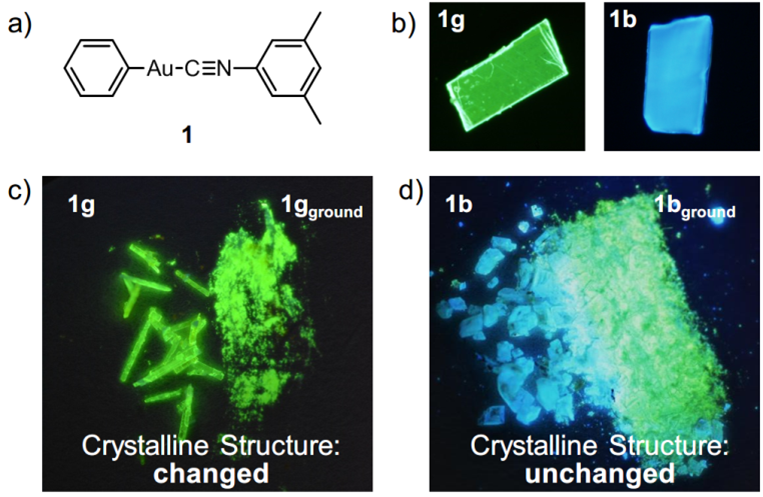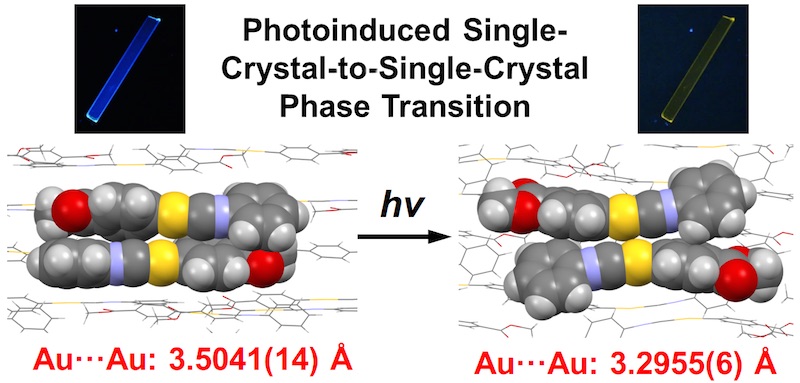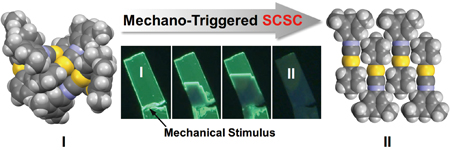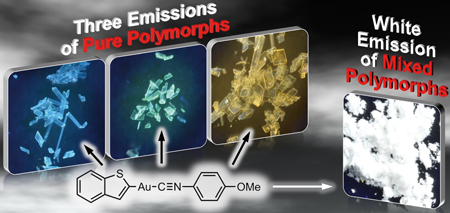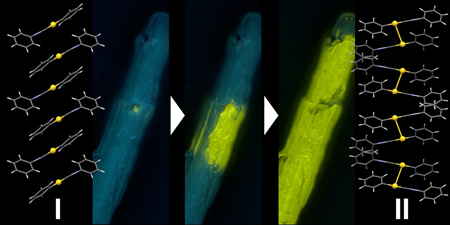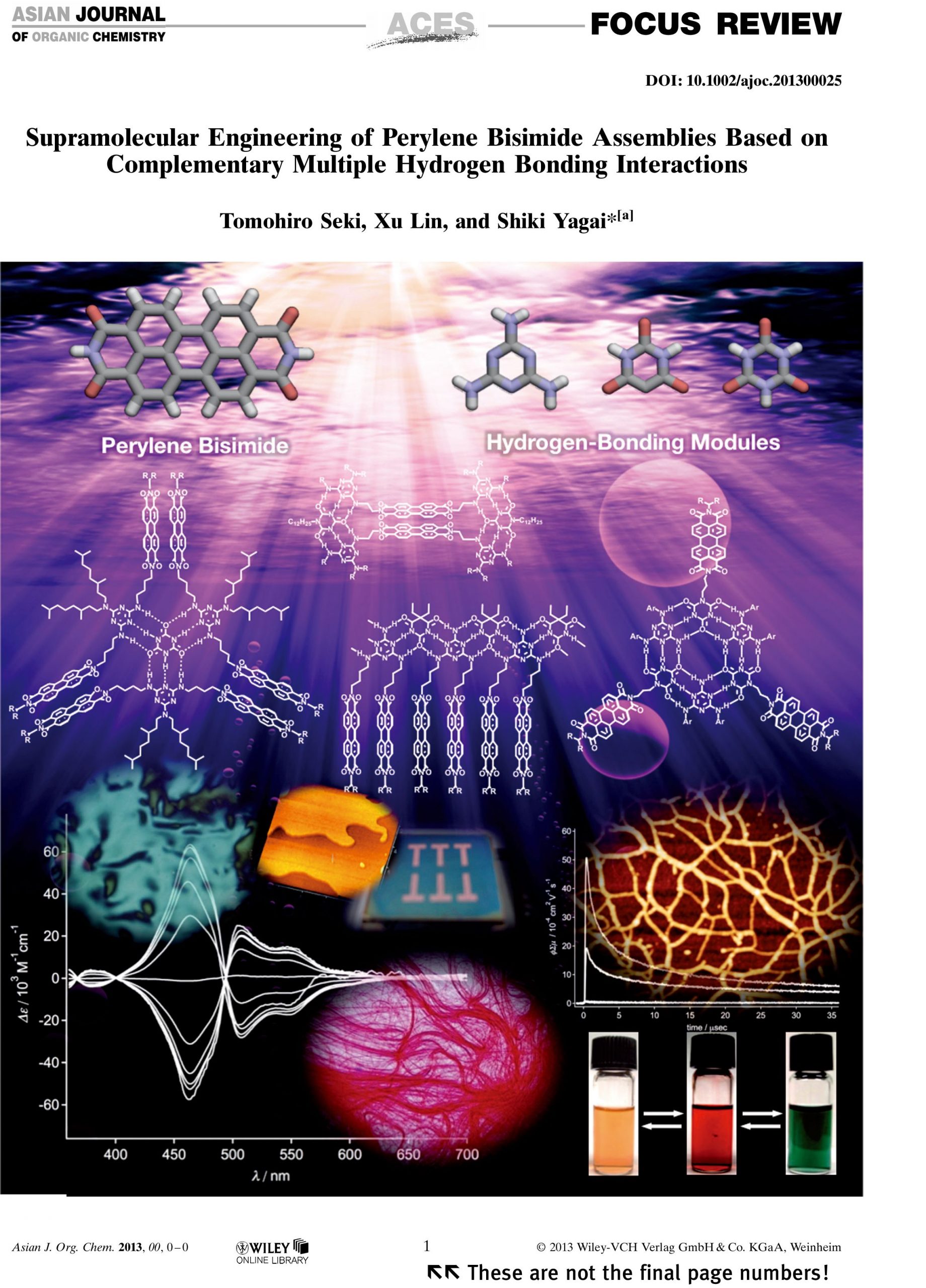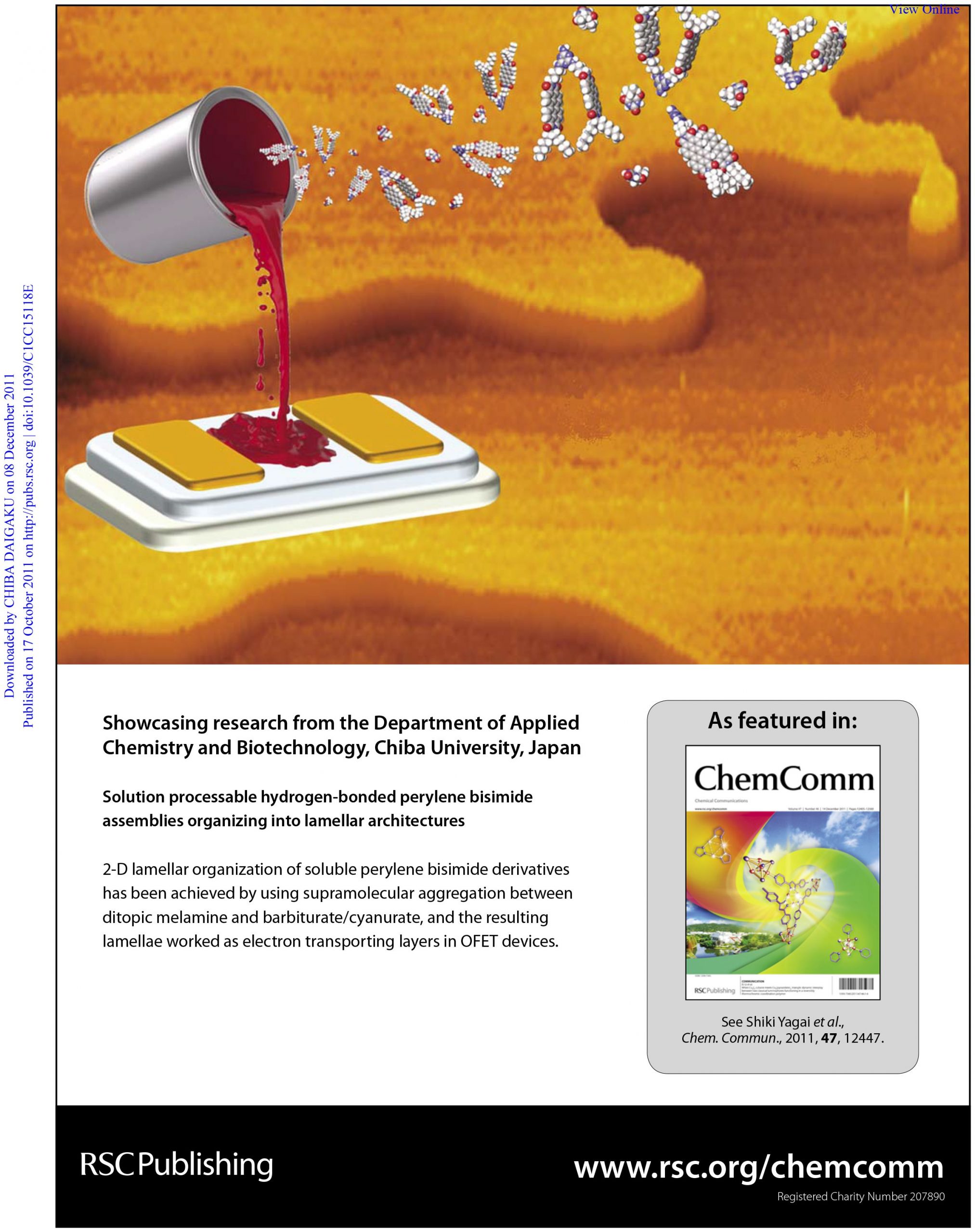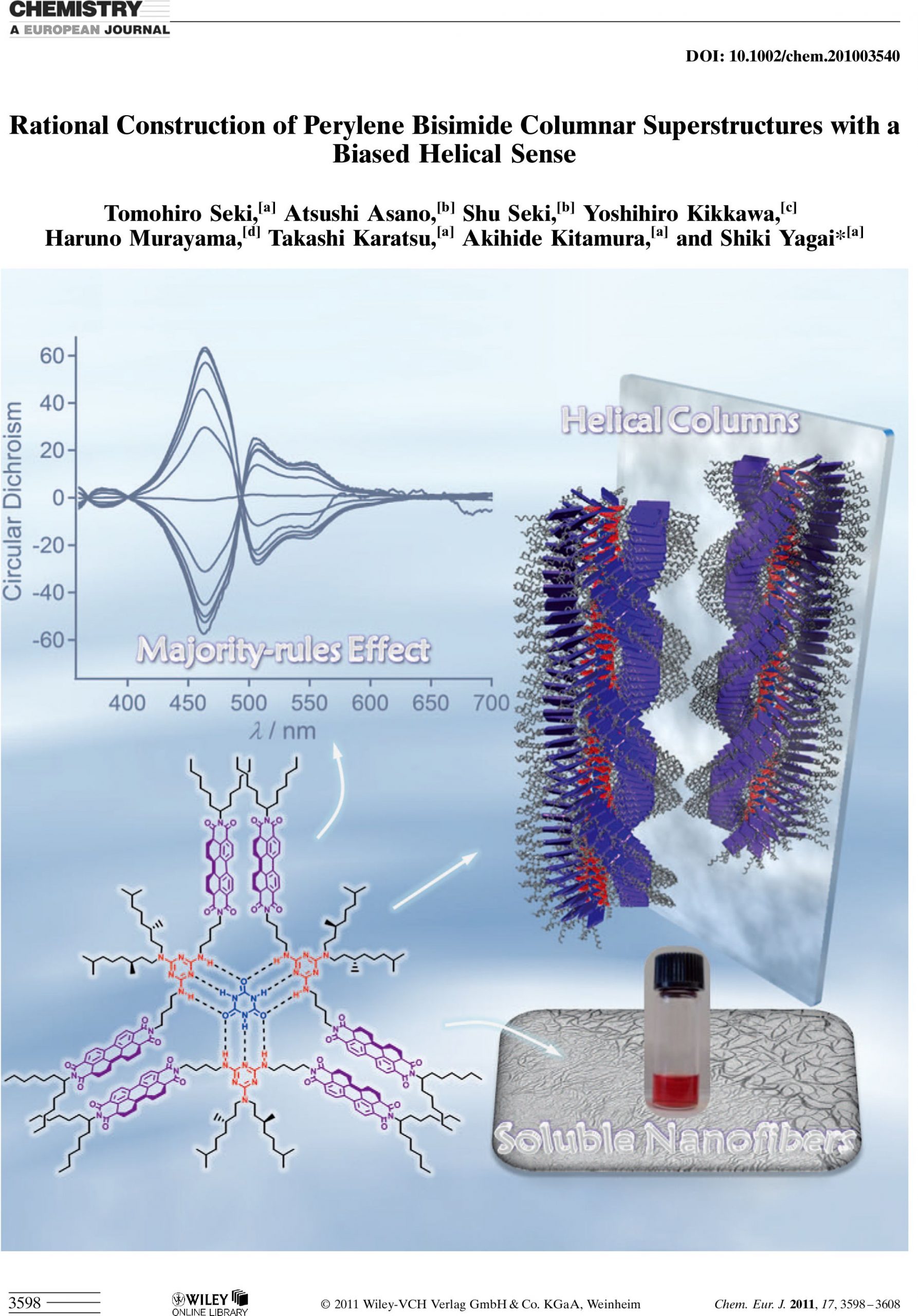2025
89. Light-OffSalientEffect:ThermalPhaseTransitionsofMolecular CrystalsControlledbyPhotoirradiation,T. Seki, T. Okada, M. Ikeda, K. Yamamoto, S. Hayashi, Y. Kishida, H. Uekusa,
J. Am. Chem. Soc.,
2025,
147, 27431–27437
DOI:
10.1021/jacs.5c04563.
88. A Platinum Complex Capable of Forming a Crystal Containing Two Distinct Molecular Arrangements, T. Seki, A. Yano,
Eur. J. Inorg. Chem.,
2025,
28, e202400793
DOI:
10.1002/ejic.202400793.
87. Luminescent Mechanochromism of a Platinum Complex with Four Monodentate Ligands Governed by Intramolecular Interactions Between Ligands,T. Seki, R. Ishikawa,
Chem. Eur. J.,
2025,
31, e202404241
DOI:
10.1002/chem.202404241.
2024
86. Benzodifuranone Crystals with Solid-State Emission Arising from the Introduction of Bulky Substituents,T. Seki, T. Okada,
Chem. Eur. J.,
2024,
30, e202402622
DOI:
10.1002/chem.202402622.
85. Preparation of intrinsically fragile bent crystals,T. Seki, S. Kobayashi, R. Ishikawa, K. Yano, T. Matsuo, S. Hayashi,
Chem. Sci.,
2024,
15, 12258–12263
DOI:
10.1039/d4sc02918f.
84. (日本語) Mechanochromic aromatic hydrocarbons that bear one simple substituent,T. Seki, K. Hattori,
RSC Adv.,
2024,
14, 7258–7262
DOI:
10.1039/d3ra08519h.
AbstractSorry, this entry is only available in Japanese.
2023
83. (日本語) Functional Molecular Crystals from the Arylation of a Halogenoplatinum Complex: Stimuli-Responsiveness, Comproportionation, and π-Bridged Dimerization, T. Seki, D. Korenaga,
Chem. Eur. J.,
2023,
29, e202302333
DOI:
10.1002/chem.202302333.
AbstractSorry, this entry is only available in Japanese.
82. Reversible Transition between Discrete and 1D Infinite Architectures: A Temperature-Responsive Cu(I) Complex with a Flexible Disilane-Bridged Bis(pyridine) Ligand,Y. Zhao, Dr. T. Nakae, Dr. S. Takeya, Dr. M. Hattori, Dr. D. Saito, Prof. M. Kato, Dr. Y. Ohmasa, S. Sato, Prof. O. Yamamuro, Dr. T. Galica, Prof. E. Nishibori, S. Kobayasi, Dr. T. Seki, Prof. T. Yamada, Dr. Y. Yamanoi,
Chem. Eur. J.,
2023,
29, e202204002
DOI:
10.1002/chem.202204002.
2022
81. Mechanical deformation and multiple thermal restoration of organic crystals: reversible multi-stage shape-changing effect with luminescence-color changes,C. Feng, T. Seki, S. Sakamoto, T. Sasaki, S. Takamizawa, H. Ito,
Chem. Sci.,
2022,
13, 9544–9551
DOI:
10.1039/D2SC03414J.
AbstractShape-memory materials can be mechanically deformed and subsequently reverse the deformation upon changing the temperature. Shape-memory materials have attracted considerable attention for basic research and industrial applications, and polymer and alloy shape-memory materials have been well studied; however, it is formidably challenging to develop functional shape-memory materials, such as materials with multi-stage and anisotropic shape changes and shape changes accompanied by changes in color and light emission. Here, we found a reversible multi-stage shape-changing effect after mechanical deformation in a molecular crystal induced by multi-step thermal phase transitions with reversible shape changes and luminescence-color changes. Using single-crystal structure and thermal analyses as well as mechanical property measurements, we found that the reversible multi-stage shape-changing effect was achieved by a combination of a twinning deformation and multi-step thermal phase transitions. The changes in the crystal shape and luminescence suggest novel strategies for imparting known shape-memory materials with additional functionalities.
2021
80. Functional Flexible Molecular Crystals: Intrinsic and Mechanoresponsive Properties,T. Seki, N. Hoshino, Y. Suzuki, S. Hayashi,
CrystEngComm,
2021,
23, 5686–5696
DOI:
10.1039/D1CE00388G.
79. (9-Isocyanoanthracene)gold(I) Complexes Exhibiting Two Modes of Crystal Jumps by Different Structure Change Mechanisms,K. Kato, T. Seki, H. Ito,
Inorg. Chem,
2021,
60, 10849–10856
DOI:
10.1021/acs.inorgchem.1c00881.
78. Synthesis and Optical Properties of C,N-Swapped Boranils Derived from Potassium Acyltrifluoroborates,S. Matsuura, J. Taguchi, T. Seki, H. Ito,
Bull. Chem. Soc. Jpn.,
2021,
94, 1547–1552
DOI:
10.1246/bcsj.20210024.
2020
77. Thermosalience in Macrocycle-Based Soft Crystals via Anisotropic Deformation of Disilanyl Architecture,K. Omoto, T. Nakae, M. Nishio, Y. Yamanoi, H. Kasai, E. Nishibori, T. Mashimo, T. Seki, H. Ito, K. Nakamura, N. Kobayashi, N. Nakayama, H. Goto, H. Nishihara,
J. Am. Chem. Soc.,
2020,
142, 12651–12657
DOI:
10.1021/jacs.0c03643.
AbstractSorry, this entry is only available in Japanese.
76. Hydrogen Bond-Directed Supramolecular Polymorphism Leading to Soft and Hard Molecular Ordering,T. Aizawa, K. Aratsu, S. Datta, T. Mashimo, T. Seki, T. Kajitani, F. Sillye, S. Yagai,
Chem. Commun.,
2020,
56, 4280–4283
DOI:
10.1039/D0CC01636E.
AbstractSorry, this entry is only available in Japanese.
75. Photoluminescent Ferroelastic Molecular Crystals,T. Seki, C. Feng, K. Kashiyama, S. Sakamoto, Y. Takasaki, T. Sasaki, S. Takamizawa, H. Ito,
Angew. Chem., Int. Ed.,
2020,
59, 8839–8843
DOI:
10.1002/anie.201914610.
AbstractFerroelasticity has been reported for several types of molecular crystals, which show mechanical‐stress‐induced shape change under twinning and/or spontaneous formation of strain. Aiming to create materials that exhibit both ferroelasticity and light‐emission characteristics, we discovered the first examples of ferroelastic luminescent organometallic crystals. Crystals of arylgold(I)(N‐heterocyclic carbene)(NHC) complexes bend upon exposure to anisotropic mechanical stress. X‐ray diffraction analyses and stress‐strain measurements on these ferroelastic crystals confirmed typical ferroelastic behavior, mechanical twinning, and the spontaneous build‐up of strain. A comparison with single‐crystal structures of related gold‐NHC complexes that do not show ferroelasticity shed light on the structural origins of the ferroelastic behavior.
74. Mixed crystal formation of two gold isocyanide complexes with various ratios for continuous tuning of photophysical properties,T. Seki, N. Toyoshima, H. Ito,
Dalton Trans.,
2020,
49, 2073–2076
DOI:
10.1039/D0DT00195C.
AbstractSorry, this entry is only available in Japanese.
73. Synthesis and Tunable Optical Properties of C,N-Chelated Borate Luminophores Derived from Potassium Acyltrifluoroborates,J. Taguchi, S. Matsuura, T. Seki, H. Ito,
Chem. Eur. J.,
2020,
26, 2450–2455
DOI:
10.1002/chem.201904983.
AbstractSorry, this entry is only available in Japanese.
72. Stacked Nanocarbon Photosensitizer for Efficient Blue Light Excited Eu(III) Emission,Y. Kitagawa, F. Suzue, T. Nakanishi, K. Fushimi, T. Seki, H. Ito, Y. Hasegawa,
Commun. Chem.,
2020,
3, 3
DOI:
10.1038/s42004-019-0251-z.
AbstractSorry, this entry is only available in Japanese.
71. Crystal Jumping of Simple Hydrocarbons: Cooling-Induced Salient Effect of Bis-, Tri-, and Tetraphenylethene through Anisotropic Lattice Dimension Changes without Thermal Phase Transitions,T. Seki, T. Mashimo, H. Ito,
Chem. Lett.,
2020,
49, 174–177
DOI:
10.1246/cl.190768.
AbstractSorry, this entry is only available in Japanese.
70. Aurophilicity-mediated Construction of Emissive Porous Molecular Crystals as Versatile Hosts for Liquid and Solid Guests,T. Seki, K. Ida, H. Sato, S. Aono, S. Sakaki, H. Ito,
Chem. Eur. J.,
2020,
26, 735–744
DOI:
10.1002/chem.201904597.
2019
69. Anisotropic Thermal Expansion as the Source of Macroscopic and Molecular Scale Motion in Phosphorescent Amphidynamic Crystals,M. Jin, S. Yamamoto, T. Seki, H. Ito, M.A. Garcia-Garibay,
Angew. Chem. Int. Ed.,
2019,
58, 18003–18010
DOI:
10.1002/anie.201909048.
AbstractSorry, this entry is only available in Japanese.
68. The Direct Dimesitylborylation of Benzofuran Derivatives via an Iridium-Catalyzed C–H Activation with Silyldimesitylborane,R. Shishido, I. Sasaki, T. Seki, T. Ishiyama, H. Ito,
Chem. Eur. J.,
2019,
25, 12924 – 12928
DOI:
10.1002/chem.201903776.
AbstractSorry, this entry is only available in Japanese.
67. Near-IR Luminescent YbIII Coordination Polymers Composed of Pyrene Derivatives for Thermostable Oxygen Sensors,Y. Hasegawa, T. Matsui, Y. Kitagawa, T. Nakanishi, T. Seki, H. Ito, Y. Nakasaka, T. Masuda, K. Fushimi,
Chem. Eur. J.,
2019,
25, 12308–12315
DOI:
10.1002/chem.201902583.
AbstractSorry, this entry is only available in Japanese.
66. Anisotropic strain release in a thermosalient crystal: Correlation between the microscopic orientation of molecular rearrangements and the macroscopic mechanical motion,T. Seki, T. Mashimo, H. Ito,
Chem. Sci.,
2019,
10, 4185–4191
DOI:
10.1039/C8SC05563G.
AbstractSorry, this entry is only available in Japanese.
65. Luminescent mechanochromism of gold N-heterocyclic carbene complexes with hypso- and bathochromic spectral shifts,T. Seki, K. Kashiyama, H. Ito,
Dalton Trans.,
2019,
48, 7105–7109
DOI:
10.1039/C9DT00566H.
AbstractSorry, this entry is only available in Japanese.
64. Dependence of Absorption and Emission Spectra on Polymorphs of Gold(I) Isocyanide Complexes: Theoretical Study with QM/MM Approach,S. Aono, T. Seki, H. Ito, S. Sakaki,
J. Phys. Chem. C.,
2019,
123, 4773–4794
DOI:
10.1021/acs.jpcc.8b10602.
AbstractSorry, this entry is only available in Japanese.
2018
63. Soft Crystal Force Field for Reproducing the Crystal Structures of Aryl Gold Isocyanide Complexes,N. Nakayama, S. Obata, Y. Hori, H. Goto, T. Seki, H. Ito,
J. Comput. Chem. Jpn.,
2018,
17, 155–157
DOI:
10.2477/jccj.2018-0031.
AbstractSorry, this entry is only available in Japanese.
62. Structural Manipulation of Triboluminescent Lanthanide Coordination Polymers by Side-Group Alteration,Y. Hirai, P. P. F. Da Rosa, T. Nakanishi, Y. Kitagawa, K. Fushimi, T. Seki, H. Ito, Y. Hasegawa,
Inorg. Chem.,
2018,
57, 14653–14659
DOI:
10.1021/acs.inorgchem.8b02367.
61. Synthesis and Evaluation of 1,3a,6a-Triazapentalene (TAP)-Bonded System,M. Ito, A. Mera, T. Mashimo, T. Seki, S. Karanjit, E. Ohashi, A. Nakayama, K. Kitamura, T. Hamura, H. Ito, K. Namba,
Chem. Eur. J.,
2018,
24, 17727–17733
DOI:
10.1002/chem.201804733.
AbstractSorry, this entry is only available in Japanese.
60. A Gold Isocyanide Complex with a Pendant Carboxy Group: Orthogonal Molecular Arrangements and Hypsochromically Shifted Luminescent Mechanochromism,T. Seki, K. Kobayashi, T. Mashimo, H. Ito,
Chem. Commun.,
2018,
54, 13160–13160
DOI:
10.1039/C8CC06490C.
59. Spiral Eu(III) Coordination Polymers with Circularly Polarized Luminescence,Y. Hasegawa, Y. Miura, Y. Kitagawa, S. Wada, T. Nakanishi, K. Fushimi, T. Seki, H. Ito, T. Iwasa, T. Taketsugu, M. Gon, Y. Chujo, S. Hattori, M. Karasawa, K. Ishii,
Chem. Commun.,
2018,
54, 10695–10697
DOI:
10.1039/C8CC05147J.
58. Light-Regulated Crystal Growth of π-Conjugated Luminophores in an Azobenzene Matrix,T. Kobayashi, Y. Kitamoto, Y. Hirai, T. Kajitani, T. Seki, S. Yagai,
Commun. Chem.,
2018,
1, 58
DOI:
10.1038/s42004-018-0061-8.
57. Spin-orbit Coupling Dependent Energy Transfer in Luminescent Nonanuclear Yb-Gd / Yb-Lu Clusters,S. Omagari, T. Nakanishi, Y. Kitagawa, T. Seki, K. Fushimi, A. Meijerink, Y. Hasegawa,
J. Lumin.,
2018,
201, 170–175
DOI:
10.1016/j.jlumin.2018.04.049.
56. meta-diisocyanide benzene-based aryl gold isocyanide complex exhibiting multiple solid-state molecular arrangements and luminescent mechanochromism,T. Seki, K. Ida, H. Ito,
Mater. Chem. Front.,
2018,
2, 1195–1200
DOI:
10.1039/C8QM00074C.
AbstractSorry, this entry is only available in Japanese.
55. Thermosensitive Luminophores Using Seven-Coordinate TbIII Complexes Based on LLCT Transition,P. P. F. Da Rosa, T. Nakanishi, Y. Kitagawa, T. Seki, H. Ito, K. Fushimi, Y. Hasegawa,
Eur. J. Inorg. Chem.,
2018, , 2031–2037
DOI:
10.1002/ejic.201800281.
54. Mechanical-Stimulation-Triggered and Solvent-Vapor-Induced Reverse Single-Crystal-to-Single-Crystal Phase Transitions with Alterations of the Luminescence Color,M. Jin, T. Sumitani, H. Sato, T. Seki, H. Ito,
J. Am. Chem. Soc.,
2018,
140, 2875–2879
DOI:
10.1021/jacs.7b12455.
AbstractSorry, this entry is only available in Japanese.
53. A Luminescent Dinuclear EuIII/TbIII Complex with LMCT Band for Single-Molecular Thermosensor,K. Yanagisawa, Y. Kitagawa, T. Nakanishi, T. Seki, K. Fushimi, H. Ito, Y. Hasegawa,
Chem. Eur. J.,
2018,
24, 1956–1961
DOI:
10.1002/chem.201705021.
52. Synthesis and Photophysical Properties of Eu(III) Complexes with Phosphine Oxide Ligands Including Metal Ions,M. Yamamoto, T. Nakanishi, Y. Kitagawa, T. Seki, H. Ito, K. Fushimi, Y. Hasegawa,
Bull. Chem. Soc. Jpn.,
2018,
91, 6–11
DOI:
10.1246/bcsj.20170241.
51. Origin of Concentration Quenching in Ytterbium Coordination Polymers: Phonon-Assisted Energy Transfer,S. Omagari, T. Nakanishi, Y. Hirai, Y. Kitagawa, T. Seki, K. Fushimi, H. Ito, Y. Hasegawa,
Eur. J. Inorg. Chem.,
2018, , 561–567
DOI:
10.1002/ejic.201701040.
2017
50. Phosphorescence Control Mediated by Molecular Rotation and Aurophilic Interactions in Amphidynamic Crystals of 1,4-bis[tri-(p-fluorophenyl)phosphane-gold(I)-ethynyl]benzene,M. Jin, T. J. Chung, T. Seki, H. Ito, M. A. Garcia-Garibay,
J. Am. Chem. Soc.,
2017,
139, 18115 –18121
DOI:
10.1021/jacs.7b11316.
AbstractSorry, this entry is only available in Japanese.
49. Tris(trimethylsilyl)silyl Boronate Esters: Novel Bulky, Air- and Moisture-Stable Silylboronate Ester Reagents for Boryl Substitution and Silaboration Reactions,E. Yamamoto, R. Shishido, T. Seki, H. Ito,
Organometallics.,
2017,
36, 3019–3022
DOI:
10.1021/acs.organomet.7b00476.
AbstractSorry, this entry is only available in Japanese.
48. Enhanced Luminescence of Asymmetrical Seven-Coordinate EuIII Complexes Including LMCT Perturbation,K. Yanagisawa, Y. Kitagawa, T. Nakanishi, T. Akama, M. Kobayashi, T. Seki, K. Fushimi, H. Ito, T. Taketsugu, Y. Hasegawa,
Eur. J. Inorg. Chem.,
2017,
2017, 3843–3848
DOI:
10.1002/ejic.201700815.
47. Tuning the Lifetime of Transient Phases of Mechanochromic Gold Isocyanide Complexes through Functionalization of the Terminal Moieties of Flexible Side Chains,T. Seki, K. Kashiyama, S. Yagai, H. Ito,
Chem. Lett.,
2017,
46, 1415–1418
DOI:
10.1246/cl.170482.
AbstractSorry, this entry is only available in Japanese.
46. Mechano-Responsive Luminescence via Crystal-to-Crystal Phase Transitions between Chiral and Non-Chiral Space Groups,M. Jin, T. Seki, H. Ito,
J. Am. Chem. Soc.,
2017,
139, 7452–7455
DOI:
10.1021/jacs.7b04073.
AbstractSorry, this entry is only available in Japanese.
45. Low-Temperature-Selective Luminescent Mechanochromism of a Thienyl Gold Isocyanide Complex,T. Seki, K. Kobayashi, H. Ito,
Chem. Commun.,
2017,
53, 6700–6703
DOI:
10.1039/C7CC03190D.
AbstractSorry, this entry is only available in Japanese.
44. Luminescent Mechanochromic 9-Anthryl Gold(I) Isocyanide Complex with an Emission Maximum at 900 nm after Mechanical Stimulation,T. Seki, N. Tokodai, S. Omagari, T. Nakanishi, Y. Hasegawa, T. Iwasa, T. Taketsugu, H. Ito,
J. Am. Chem. Soc.,
2017,
139, 6514–6517
DOI:
10.1021/jacs.7b00587.
AbstractSorry, this entry is only available in Japanese.
43. Triboluminescence of Lanthanide Coordination Polymers with Face-to-Face Arranged Substituents,Y. Hirai, T. Nakanishi, Y. Kitagawa, K. Fushimi, T. Seki, H. Ito, Y. Hasegawa,
Angew. Chem. Int. Ed.,
2017,
56, 7171–7175
DOI:
10.1002/anie.201703638.
AbstractSorry, this entry is only available in Japanese.
42. Effective Photo- and Triboluminescent Europium(III) Coordination Polymers with Rigid Triangular Spacer Ligands,Y. Hasegawa, S. Tateno, M. Yamamoto, T. Nakanishi, Y. Kitagawa, T. Seki, H. Ito, K. Fushimi,
Chem. Eur. J.,
2017,
23, 2666–2672
DOI:
10.1002/chem.201605054.
2016
41. Critical Role of Energy Transfer Between Terbium Ions for Suppression of Back Energy Transfer in Nonanuclear Terbium Clusters,S. Omagari, T. Nakanishi, Y. Kitagawa, T. Seki, K. Fushimi, H. Ito, A. Meijerink, Y. Hasegawa,
Sci. Rep.,
2016,
6, 37008
DOI:
10.1038/srep37008.
AbstractSorry, this entry is only available in Japanese.
40. Introduction of a Biphenyl Moiety for a Solvent Responsive Aryl Gold(I) Isocyanide Complex with Mechanical Reactivation,T. Seki, M. Jin, H. Ito,
Inorg. Chem.,
2016,
55, 12309–12320
DOI:
10.1021/acs.inorgchem.6b02107.
AbstractSorry, this entry is only available in Japanese.
39. Direct Introduction of a Dimesitylboryl Group Using Base-Mediated Substitution of Aryl Halides with Silyldimesitylborane,E. Yamamoto, K. Izumi, R. Shishido, T. Seki, N. Tokodai, H. Ito,
Chem. Eur. J.,
2016,
22, 17547– 17551
DOI:
10.1002/chem.201604021.
AbstractSorry, this entry is only available in Japanese.
38. Luminescent Europium(III) Coordination Zippers Linked with Thiophene-Based Bridges,Y. Hirai, T. Nakanishi, Y. Kitagawa, K. Fushimi, T. Seki, H. Ito, Y. Hasegawa,
Angew. Chem., Int. Ed.,
2016,
55, 12059–12062
DOI:
10.1002/anie.201606371.
AbstractSorry, this entry is only available in Japanese.
37. Luminescent mechanochromism of a chiral complex: Distinct crystal structure and color changes of racemic and homochiral gold(I) isocyanide complexes with a binaphthyl moiety,M. Jin, T. Seki, H. Ito,
Chem. Commun.,
2016,
52, 8083–8086
DOI:
10.1039/C6CC03541H.
36. A Screening Approach for the Discovery of Mechanochromic Gold(I) Isocyanide Complexes with Crystal-to-Crystal Phase Transitions,T. Seki, Y. Takamatsu, H. Ito,
J. Am. Chem. Soc.,
2016,
138, 6252 –6260
DOI:
10.1021/jacs.6b02409.
AbstractSorry, this entry is only available in Japanese.
35. Hyper-stable organo-EuIII luminophore under high temperature for photo-industrial application,A. Nakajima, T. Nakanishi, Y. Kitagawa, T. Seki, H. Ito, K. Fushimi, Y. Hasegawa,
Sci. Rep.,
2016,
DOI:
10.1038/srep24458.
AbstractSorry, this entry is only available in Japanese.
34. Mechanical Path to a Photogenerated Structure: Ball Milling-Induced Phase Transition of a Gold(I) Complex,T. Seki, K. Sakurada, M. Muromoto, S. Seki, H. Ito,
Chem. Eur. J.,
2016,
18, 7217 –7220
DOI:
10.1039/C5CE02565F.
AbstractSorry, this entry is only available in Japanese.
33. Molecular-Level Understanding of Structural Changes of Organic Crystals Induced by Macroscopic Mechanical Stimulation,T. Seki, H. Ito,
Chem. Eur. J.,
2016,
22, 4322–4329
DOI:
10.1002/chem.201504361.
32. Detailed Investigation of the Structural, Thermal, and Electronic Properties of Gold Isocyanide Complexes with Mechano-Triggered Single,T. Seki, K. Sakurada, M. Muromoto, S. Seki, H. Ito,
Chem. Eur. J.,
2016,
22, 6, 1968–1978
DOI:
10.1002/chem.201503721.
2015
31. Mechanochromic Luminescence Based on Crystal-to-Crystal Transformation Mediated by a Transient Amorphous,S. Yagai, T. Seki, H. Aonuma, K. Kawabuchi, T. Karatsu, T. Okura, A. Sakon, H. Uekusa, H. Ito,
Chem. Mat.,
2015,
28, 234 – 241
DOI:
10.1021/acs.chemmater.5b03932.
AbstractSorry, this entry is only available in Japanese.
30. Seven-Coordinate Luminophores: Brilliant Luminescence of Lanthanide Complexes with C3v Geometrical Structures,K. Yanagisawa, T. Nakanishi, Y. Kitagawa, T. Seki, T. Akama, M. Kobayashi, T. Taketsugu, H. Ito, K. Fushimi, Y. Hasegawa,
Eur. J. Inorg. Chem.,
2015, , 4769–4774
DOI:
10.1002/ejic.201500820.
AbstractSorry, this entry is only available in Japanese.
29. Mismatched changes of the photoluminescence and crystalline structure of a mechanochromic gold(I) isocyanide complex,T. Seki, K. Sakurada, H. Ito,
Chem. Comm.,
2015,
51, 13933–13936
DOI:
10.1039/C5CC04609B.
AbstractSorry, this entry is only available in Japanese.
28. Enhanced Electric Dipole Transition in Lanthanide Complex with Organometallic Ruthenocene Units,Y. Hasegawa, N. Sato, Y. Hirai, T. Nakanishi, Y. Kitagawa, A. Kobayashi, M. Kato, T. Seki, H. Ito, K. Fushimi,
J. Phys. Chem. A,
2015,
119, 4825 –4833
DOI:
10.1021/acs.jpca.5b01809.
AbstractSorry, this entry is only available in Japanese.
27. Luminescent Coordination Glass: Remarkable Morphological Strategy for Assembled Eu(III) Complexes,Y. Hirai, T. Nakanishi, Y. Kitagawa, K. Fushimi, T. Seki, H. Ito, H. Fueno, K. Tanaka, T. Sato, Y. Hasegawa,
Inorg. Chem.,
2015,
54, 4364–4370
DOI:
10.1021/acs.inorgchem.5b00145.
AbstractSorry, this entry is only available in Japanese.
26. Effective Photosensitized Energy Transfer of Nonanuclear Terbium Clusters Using Methyl Salicylate Derivatives,S. Omagari, T. Nakanishi, T. Seki, Y. Kitagawa, Y. Takahata, K. Fushimi, H. Ito, Y. Hasegawa,
J. Phys. Chem. A,
2015,
119, 1943–1947
DOI:
10.1021/jp512892f.
AbstractSorry, this entry is only available in Japanese.
25. Interconvertible Multiple Photoluminescence Color of a Gold(I) Isocyanide Complex in the Solid State: Solvent-Induced Blue-Shifted and Mechano-Responsive Red-Shifted Photoluminescence,T. Seki, T. Ozaki, T. Ohkura, K. Asakura, A. Sakon, H. Uekusa, H. Ito,
Chem. Sci.,
2015,
6, 2187–2195
DOI:
10.1039/C4SC03960B.
AbstractSorry, this entry is only available in Japanese.
24. Photoinduced Single-Crystal-to-Single-Crystal Phase Transition and Photosalient Effect of a Gold(I) Isocyanide Complex with Shortening Intermolecular Aurophilic Bonds,T. Seki, K. Sakurada, M. Muromoto, H. Ito,
Chem. Sci.,
2015,
6, 1491–1497
DOI:
10.1039/C4SC02676D.
AbstractSorry, this entry is only available in Japanese.
2014
23. Enhancement of Optical Faraday Effect of Nonanuclear Tb(III) Complexes,T. Nakanishi, Y. Suzuki, Y. Doi, T. Seki, H. Koizumi, K. Fushimi, K. Fujita, Y. Hinatsu, H. Ito, K. Tanaka, Y. Hasegawa,
inorg. Chem.,
2014,
53, 7635–7641
DOI:
10.1021/ic5009363.
AbstractSorry, this entry is only available in Japanese.
22. Design amphiphilic dipolar π-systems for stimuli-responsive luminescent materials using metastable states,S. Yagai, S. Okamura, Y. Nakano, M. Yamauchi, K. Kishikawa, T. Karatsu, A. Kitamura, A. Ueno, D. Kuzuhara, H. Yamada, T. Seki, H. Ito,
Nature Communications,
2014, , 4013
DOI:
10.1038/ncomms5013.
AbstractSorry, this entry is only available in Japanese.
21. A Perylene Bisimide Organogelator for Chlorinated Solvents,X. Lin, M. Hirono, H. Kurata, T. Seki, Y. Maruya, K. Nakayama, S. Yagai,
Asi. J. Org. Chem.,
2014,
3, 128 –132
DOI:
10.1002/ajoc.201300252.
AbstractSorry, this entry is only available in Japanese.
2013
20. Cholesterol-Aided Construction of Distinct Self-Organized Materials from Luminescent Gold(I)-Isocyanide Complex Exhibiting Mechanochromic Luminescence,K. Kawaguchi, T. Seki, T. Karatsu, A. Kitamura, H. Ito, S. Yagai,
Chem. Commun.,
2013,
19, 11391–11394
DOI:
10.1039/C3CC47162D.
AbstractSorry, this entry is only available in Japanese.
19. Controlling Mechano- and Seeding-Triggered Single-Crystal-to-Single-Crystal Phase Transition: Molecular Domino with a Disconnection of Aurophilic Bonds,T. Seki, K. Sakurada, H. Ito,
Angew. Chem., Int. Ed.,
2013,
52, 12828–12832
DOI:
10.1002/anie.201307672.
18. Luminescence Color-Tuning through Polymorph Doping: Preparation of a White-Emitting Solid from a Single Gold(I)-socyanide Complex by Simple Precipitation,T. Seki, S. Kurenuma, H. Ito,
Chem. Eur. J.,
2013,
19, 16214–16220
DOI:
10.1002/chem.201303394.
17. Doping Effect of CBP in Bulk-Heterojunction Photovoltaic Devices Composed of P3HT and Soluble Perylene Bisimid,Y. Tani, T. Seki, X. Lin, H. Kurata, S. Yagai, K. Nakayama,
Mol. Cryst. Liq. Cryst.,
2013,
578, 88–94
DOI:
10.1080/15421406.2013.804393.
16. Effect of Ligand Polarization on Asymmetric Structural Formation for Strongly Luminescent Lanthanide Complexes,Y. Hasegawa, T. Ohkubo, T. Nakanishi, A. Kobayashi, M. Kato, T. Seki, H. Ito, K. Fushimi,
Eur. J. Inorg. Chem.,
2013, , 5911 –5918
DOI:
10.1002/ejic.201301102.
AbstractSorry, this entry is only available in Japanese.
15. Mechanical stimulation and solid seeding trigger single-crystal-to-single-crystal molecular domino transformations,H. Ito, M. Muromoto, S. Kurenuma, S. Ishizaka, N. Kitamura, H. Sato, T. Seki,
Nature Communications,
2013,
4, 2009
DOI:
10.1038/ncomms3009.
AbstractSorry, this entry is only available in Japanese.
14. Covalent Modular Approach for Dimension-Controlled Self-Organization of Perylene Bisimide Dyes,X. Lin, M. Hirono, T. Seki, H. Kurata, T. Karatsu, A. Kitamura, D. Kuzuhara, H. Yamada, T. Ohba, A. Saeki, S. Seki, S. Yagai,
Chem. Eur. J.,
2013,
19, 6561–6565
DOI:
10.1002/chem.201300039.
13. Supramolecular Engineering of Perylene Bisimide Assemblies Based on Complementary Multiple Hydrogen Bonding Interactions,T. Seki, X. Lin, S. Yagai, T. Nakanishi,
Asi. J. Org. Chem.,
2013,
2, 708–724
DOI:
10.1002/ajoc.201300025.
12. Alkylated-C60 Based Soft Materials: Regulation of Self-Assembly and Optoelectronic Properties by Chain Branching,H. Li, S. S. Babu, S. T. Turner, D. Neher, M. J. Hollamby, T. Seki, S. Yagai, Y. Deguchi, H. Mohwalda, T. Nakanishi,
J. Mater. Chem. C,
2013,
1, 1943–1951
DOI:
10.1039/c3tc00066d.
2012
11. Supramolecularly Engineered Perylene Bisimides Assemblies Exhibiting Thermal Transition from Columnar to Multilamellar Structures,S. Yagai, M. Usui, T. Seki, H. Murayama, Y. Kikkawa, S. Uemura, T. Karatsu, A. Kitamura, A. Asano, S. Seki,
J. Am. Chem. Soc.,
2012,
134, 7983–7994
DOI:
10.1021/ja302574b.
AbstractSorry, this entry is only available in Japanese.
10. Perylene Bisimide Organogels Formed by Melamine・Cyanurate/Barbiturate Hydrogen-Bonded Tapes,T. Seki, S. Yagai, T. Karatsu, A. Kitamura,
Polymer Journal,
2012,
44, 600–606
DOI:
10.1038/pj.2012.22.
AbstractSorry, this entry is only available in Japanese.
2011
9. Solution Processable Hydrogen-Bonded Perylene Bisimide Assemblies Organizing into Lamellar Architectures,T. Seki, Y. Maruya, K. Nakayama, T. Karatsu, A. Kitamura, S. Yagai,
Chem. Commun.,
2011,
47, 12447–12449
DOI:
10.1039/c1cc15118e.
8. Multifunctional, Polymorphic, Ionic Fullerene Supramolecular Materials: Self-Assembly and Thermotropic Properties,H. Li, M. J. Hollamby, T. Seki, S. Yagai, H. Mohwald, T. Nakanishi,
Langmuir,
2011,
27, 7493–7501
DOI:
10.1021/la2015176.
AbstractSorry, this entry is only available in Japanese.
7. Rational Construction of Perylene Bisimide Columnar Superstructures with Biased Helical Sense,T. Seki, A. Asano, S. Seki, Y. Kikkawa, H. Murayama, T. Karatsu, A. Kitamura, S. Yagai,
Chem. Eur. J.,
2011,
17, 3598–3608
DOI:
10.1002/chem.201003540.
2010
6. Structural and Electronic Properties of Extremely Long Perylene Bisimide Nanofibers Formed through a Stoichiometrically Mismatched, Hydrogen-Bonded Complexation,S. Yagai, T. Seki, H. Murayama, Y. Wakikawa, T. Ikoma, T. Karatsu, A. Kitamura, Y. Honsho, S. Seki,
Small,
2010,
6, 2731– 2740
DOI:
10.1002/smll.201001344.
AbstractSorry, this entry is only available in Japanese.
5. Assembly of Fullerene-Carbon Nanotubes: Temperature Indicator for Photothermal Conversion,Y. Shen, A. G. Skirtach, T. Seki, S. Yagai, H. Li, H. Mowald, T. Nakanishi,
J. Am. Chem. Soc.,
2010,
132, 8566 –8568
DOI:
10.1021/ja1026024.
AbstractSorry, this entry is only available in Japanese.
2009
4. Unconventional Hydrogen-bond-directed Hierarchical Co-assembly between Perylene Bisimide and Azobenzene-Functionalized Melamine,S. Yagai, Hamamura, S.H. Wang, V. Stepanenko, T. Seki, K. Unoike, Y. Kikkawa, T. Karatsu, A. Kitamura,
Org. Biomol. Chem.,
2009,
7, 3926–3929
DOI:
10.1039/b912809c.
AbstractSorry, this entry is only available in Japanese.
2008
3. Miniaturization of Nanofibers Composed of Melamine-appended Perylene Bisimides and Cyanurates,T. Seki, S. Yagai, T. Karatsu, A. Kitamura,
Chem. Lett.,
2008,
73, 3328 –3335
DOI:
10.1246/cl.2008.764.
AbstractSorry, this entry is only available in Japanese.
2. Formation of Supramolecular Polymers and Discrete Dimers of Perylene Bisimide Dyes Based on Melamine-Cyanurates Hydrogen-Bonding Interactions,T. Seki, S. Yagai, T. Karatsu, A. Kitamura,
J. Org. Chem.,
2008,
73, 3328– 3335
DOI:
10.1021/jo800338f.
1. Transformation from H- to J-Aggregated Perylene Bisimide Dyes by Complexation with Cyanurates,S. Yagai, T. Seki, T. Karatsu, A. Kitamura, F. Wurthner,
Angew. Chem. Int.Ed.,
2008,
47, 3367–3371
DOI:
10.1002/anie.200705385.
